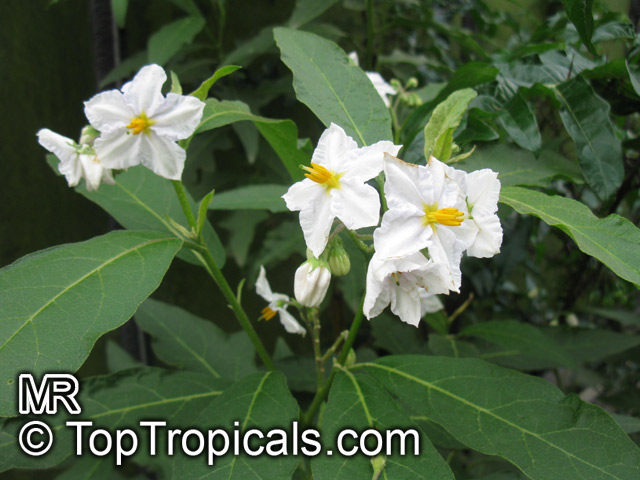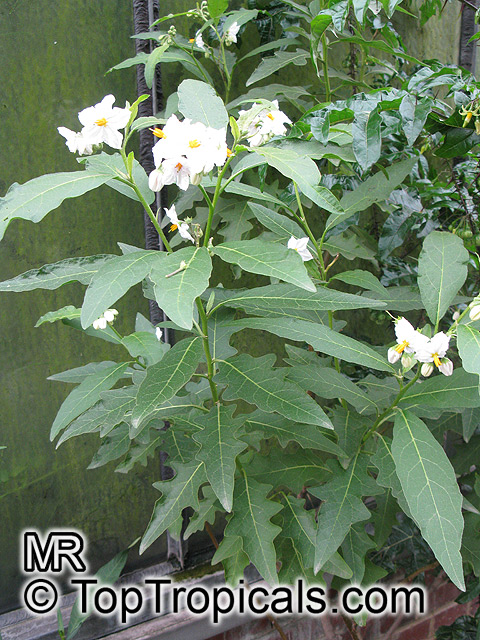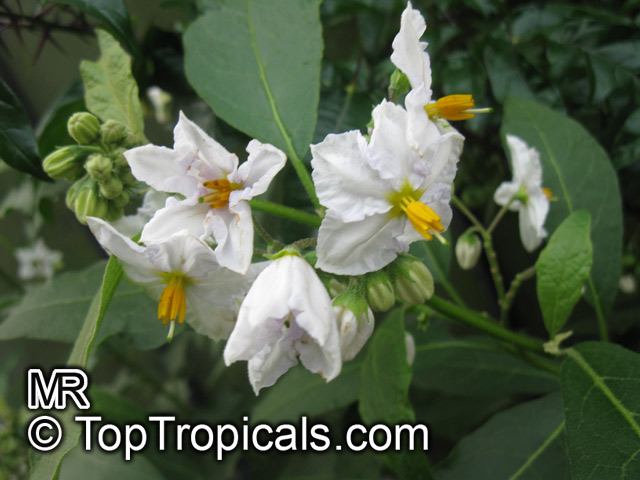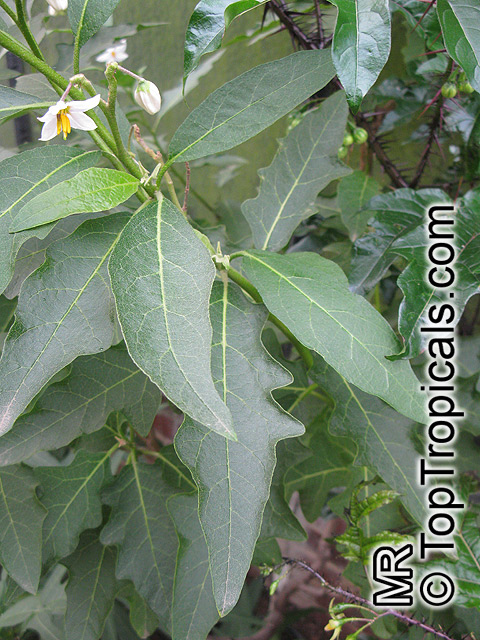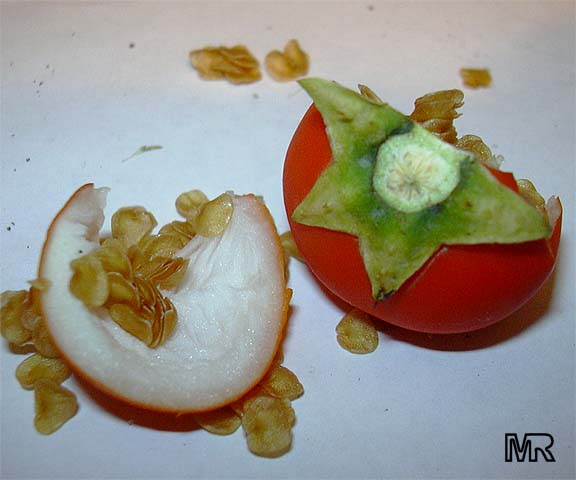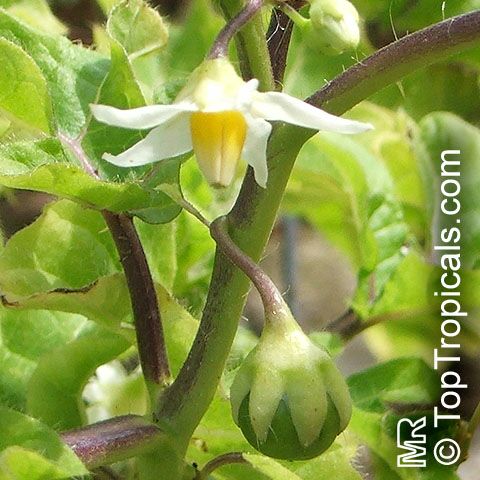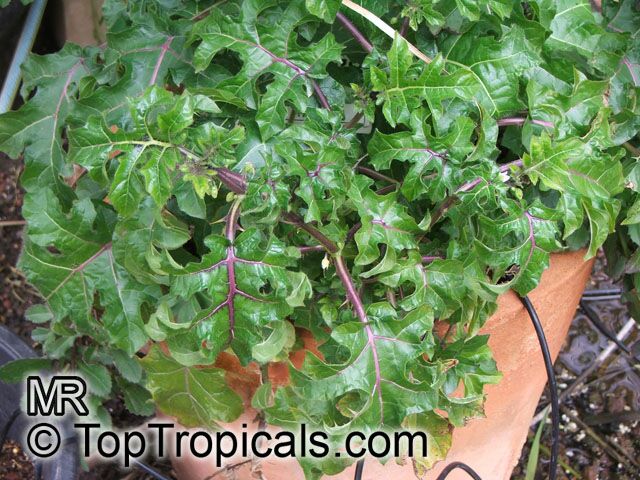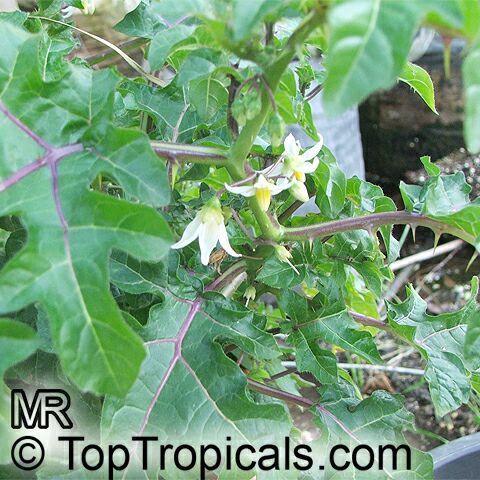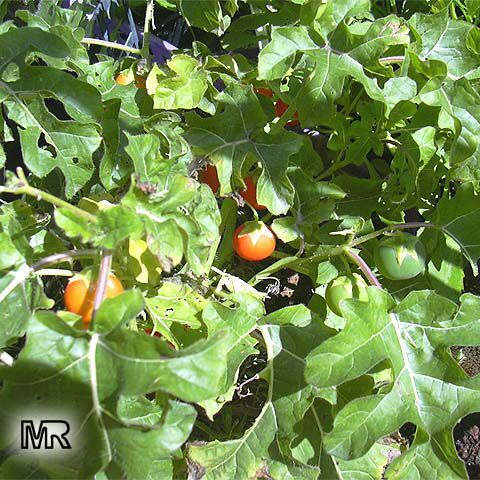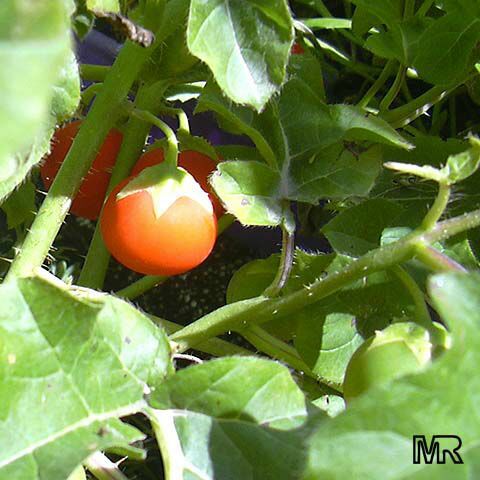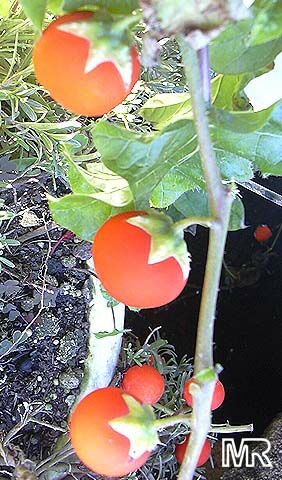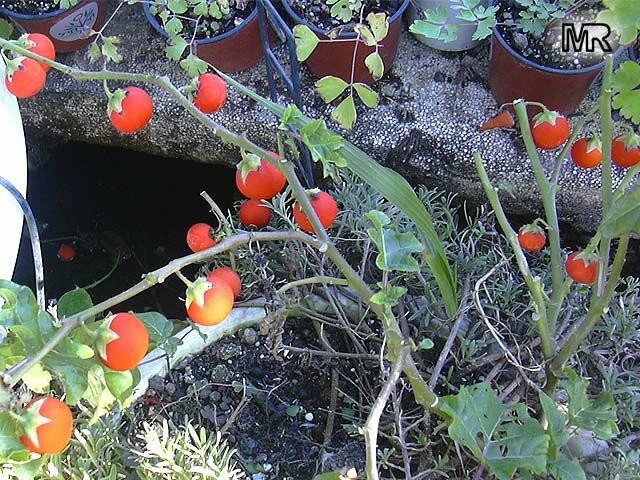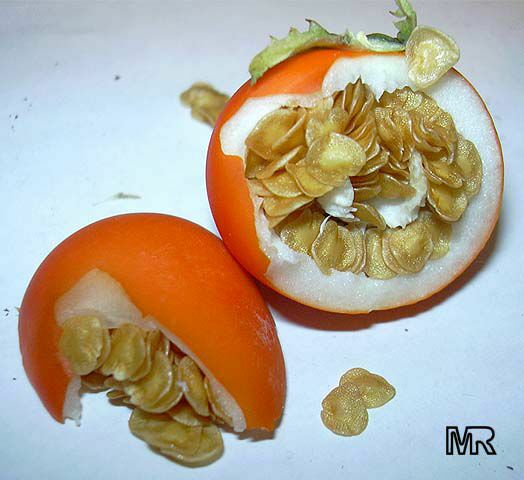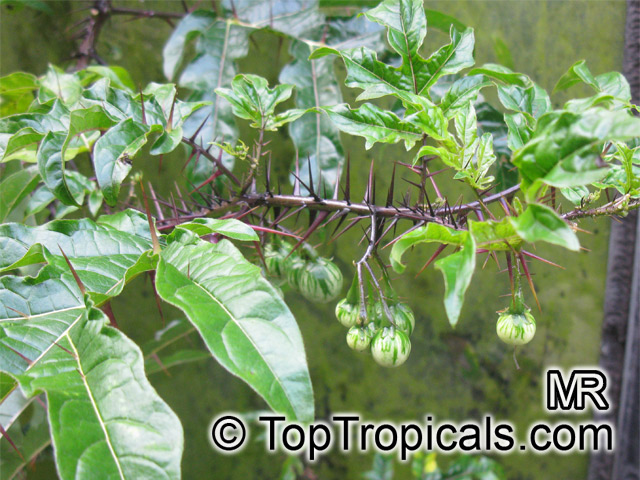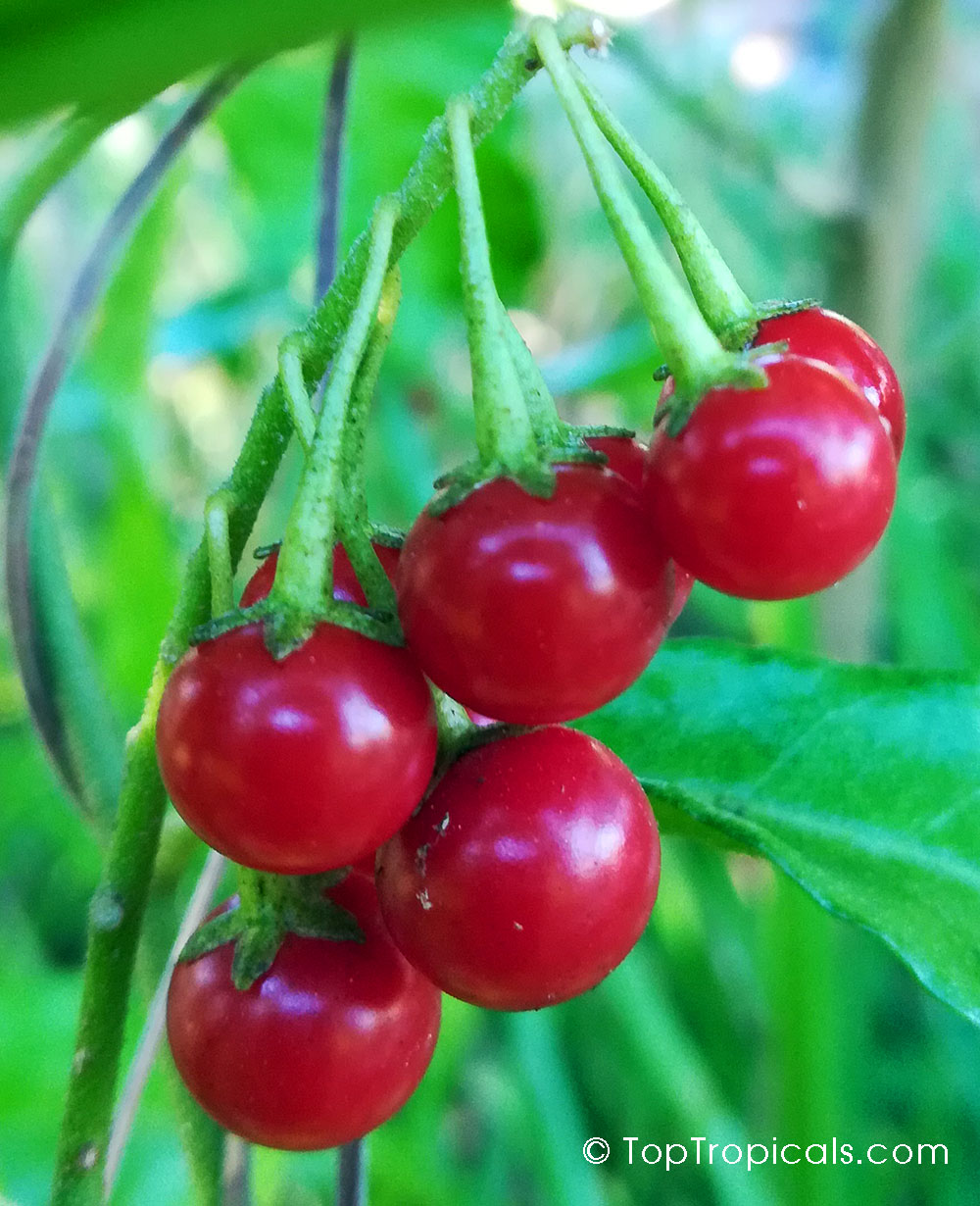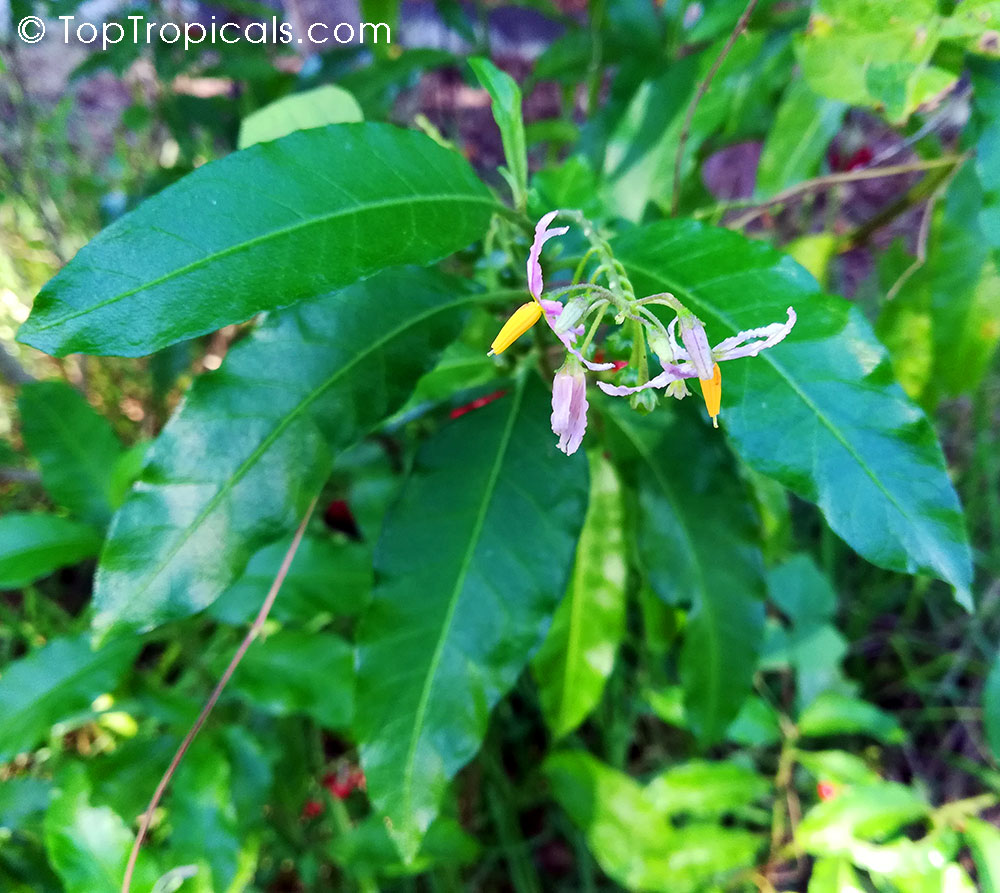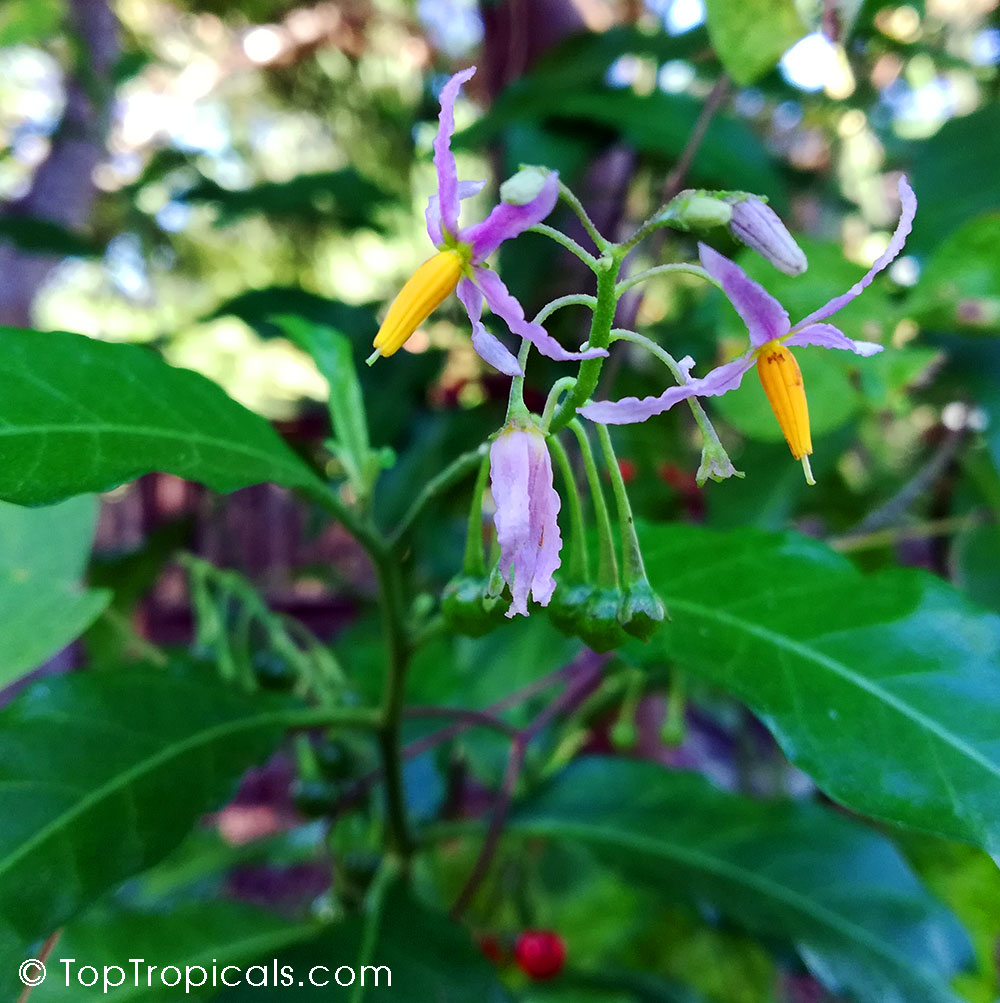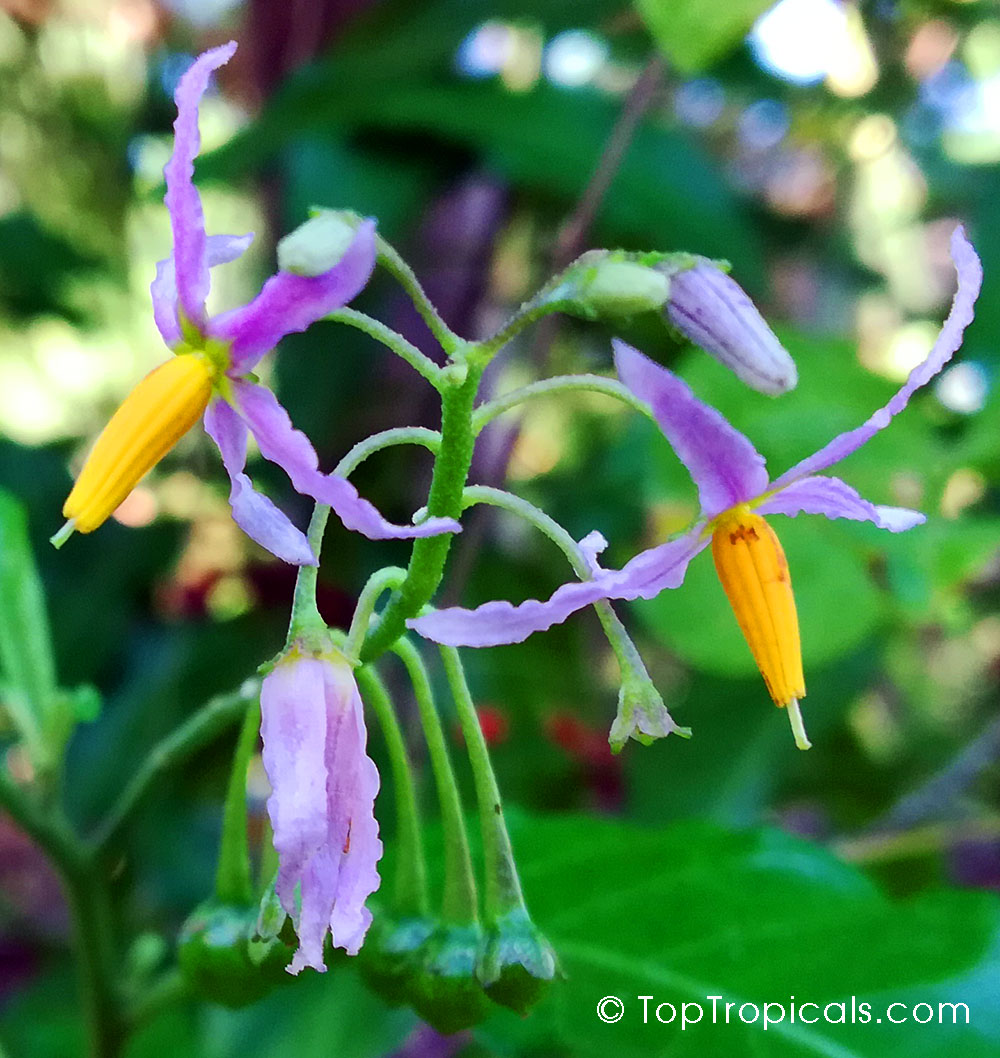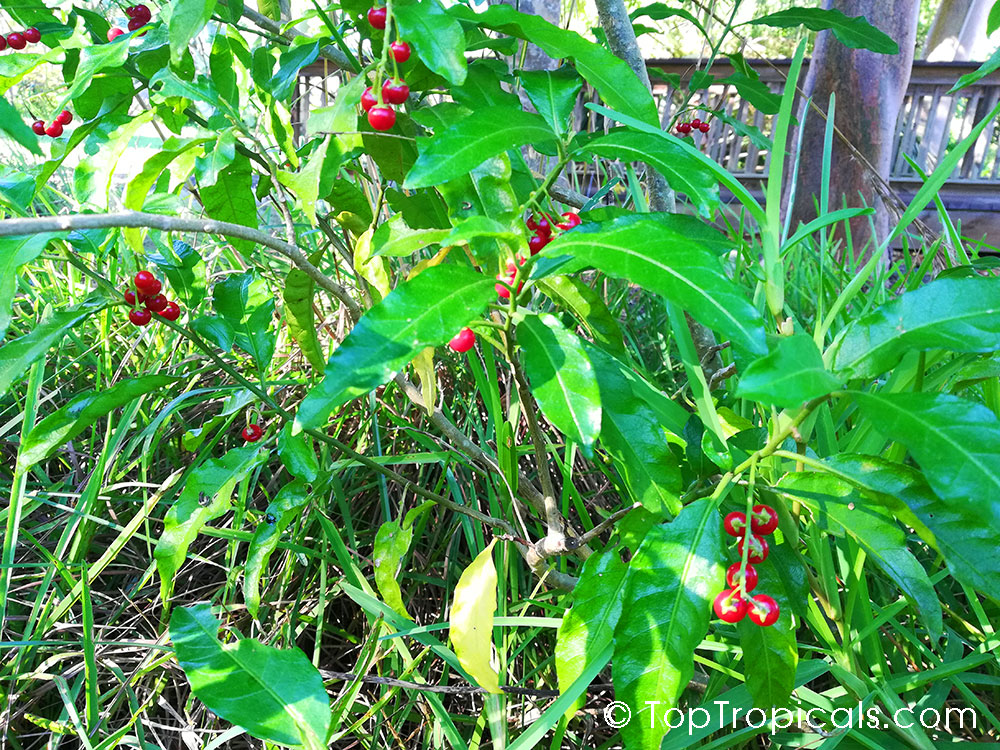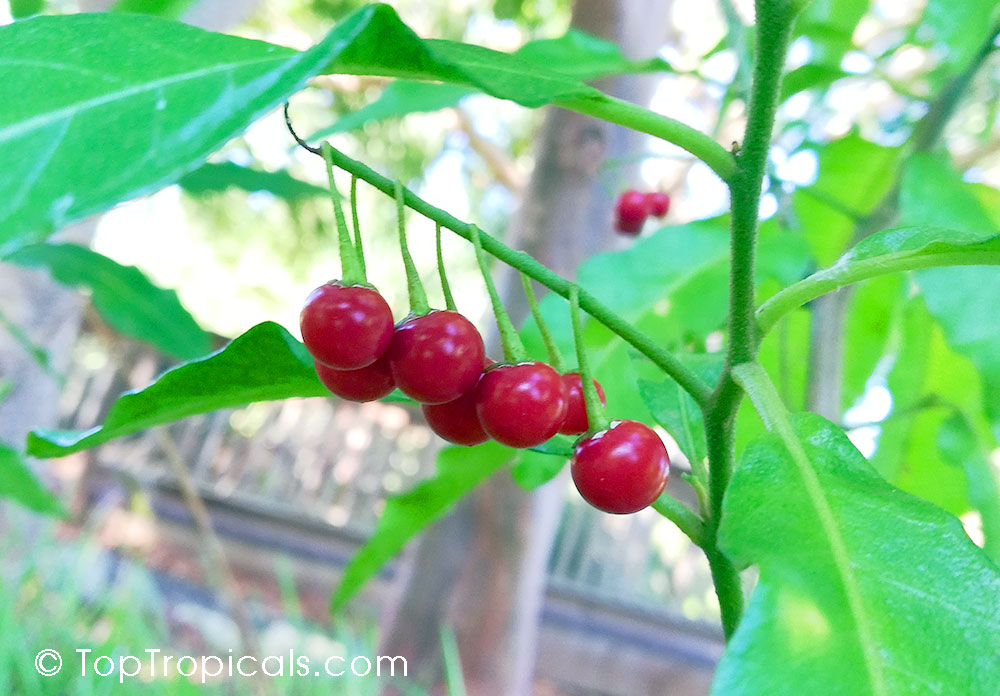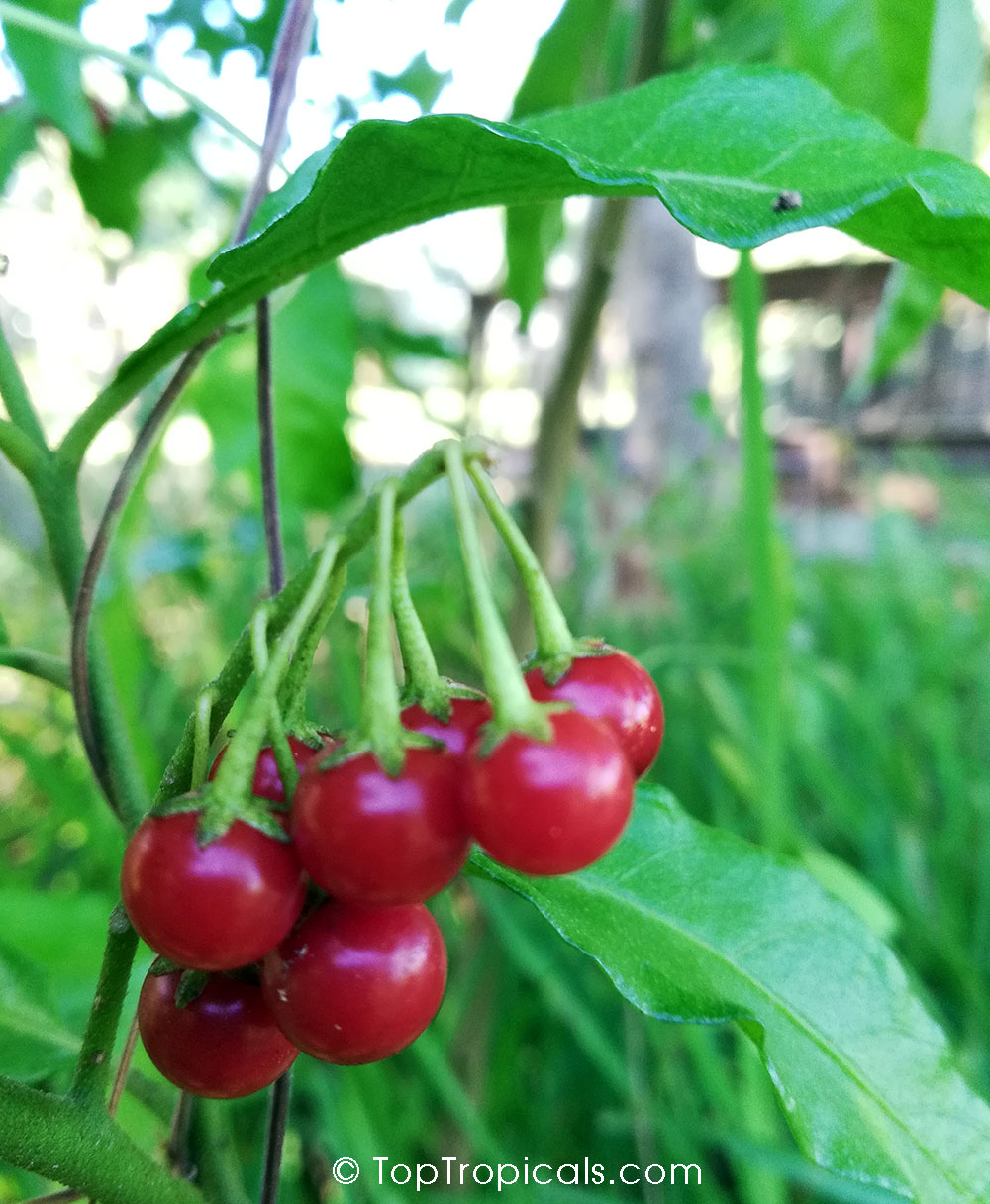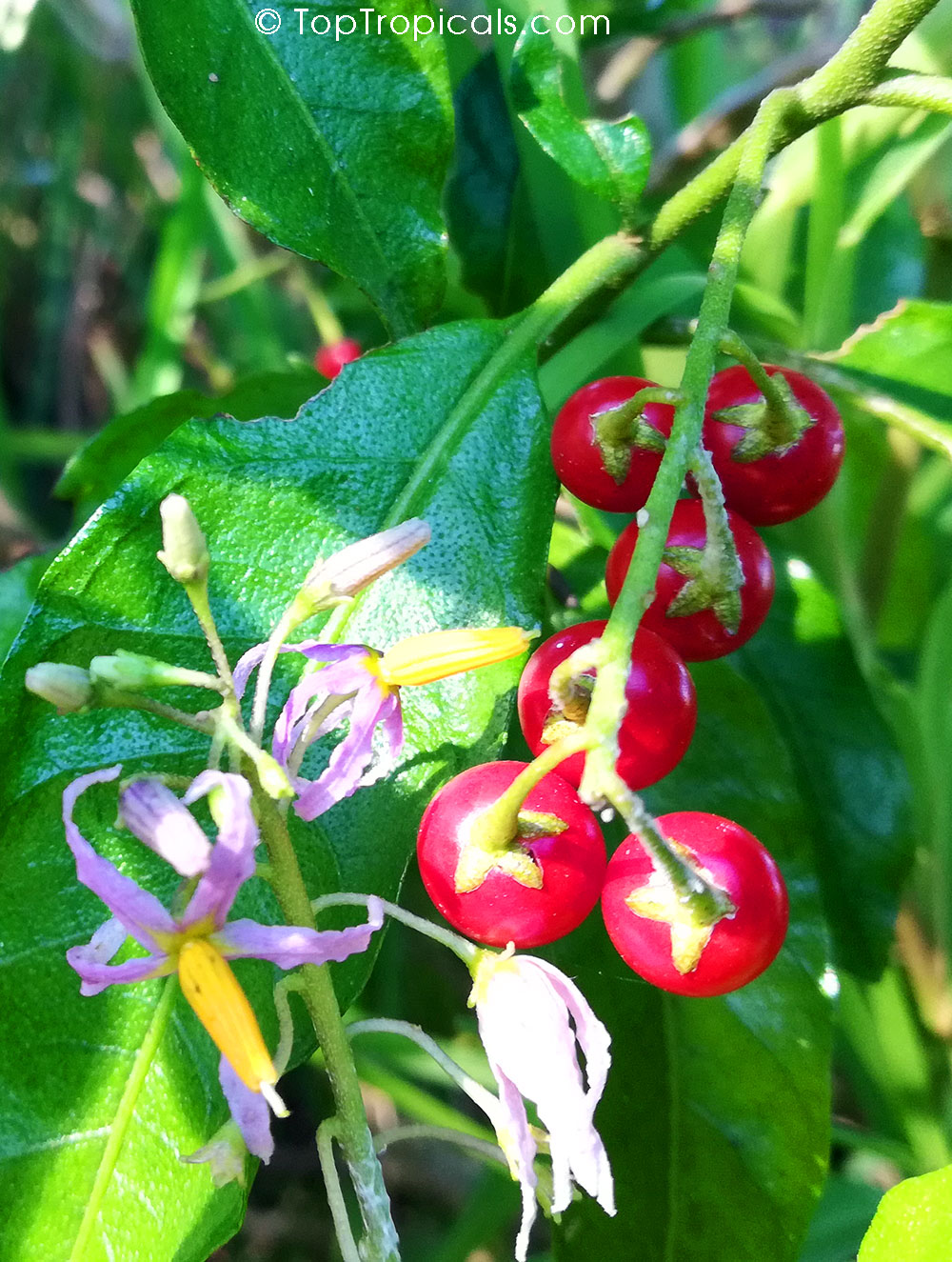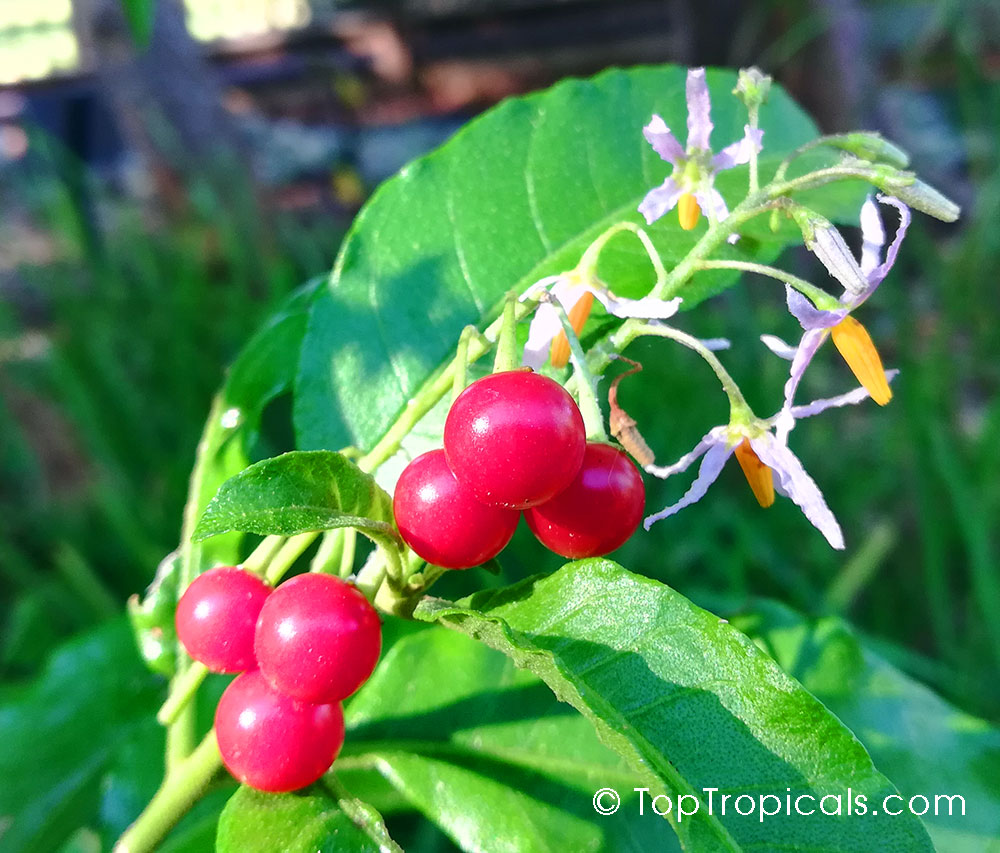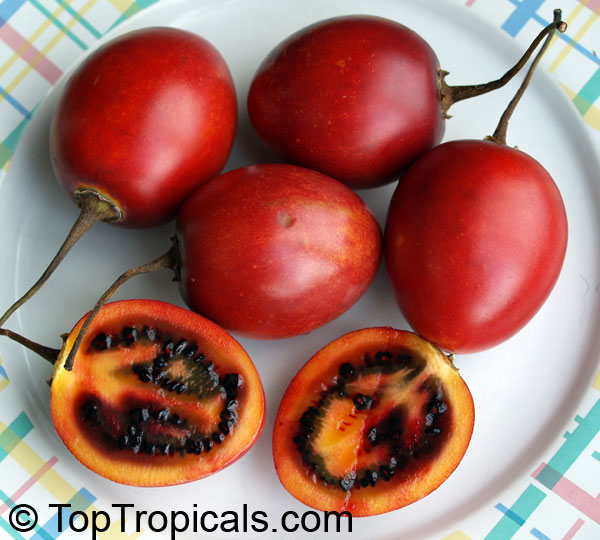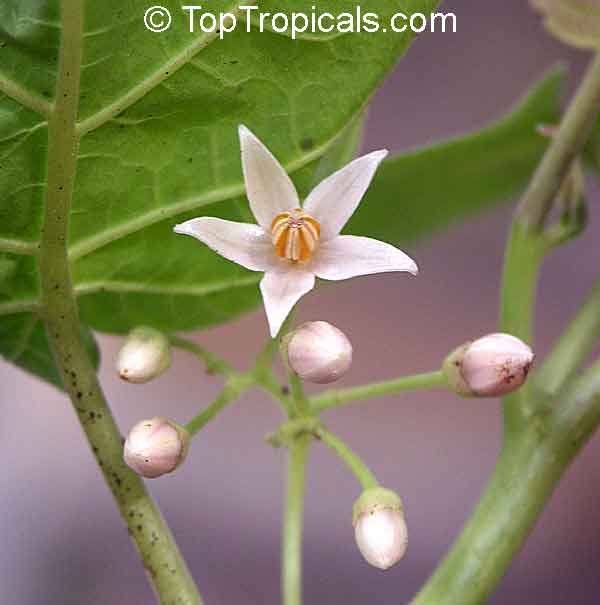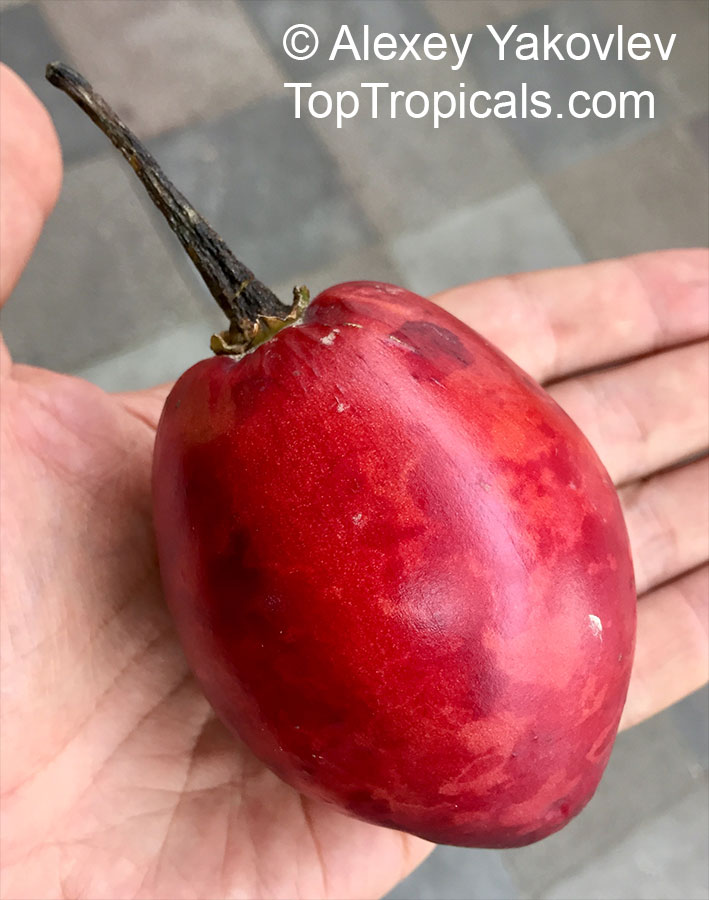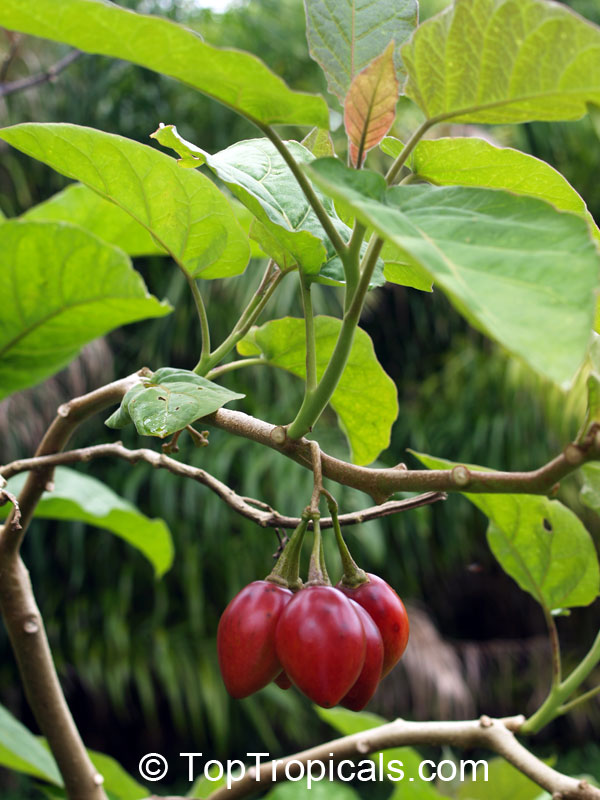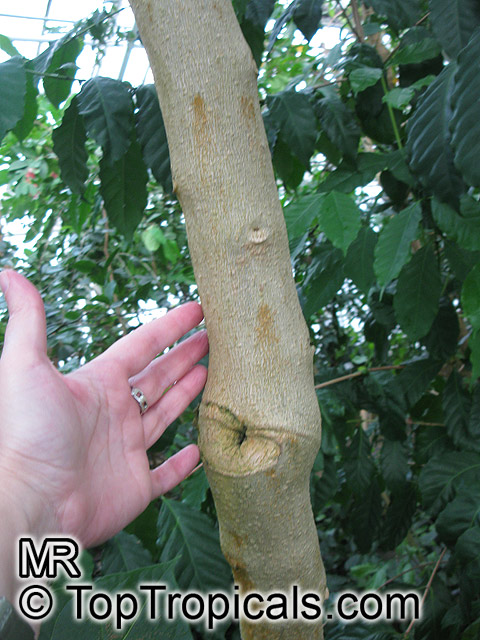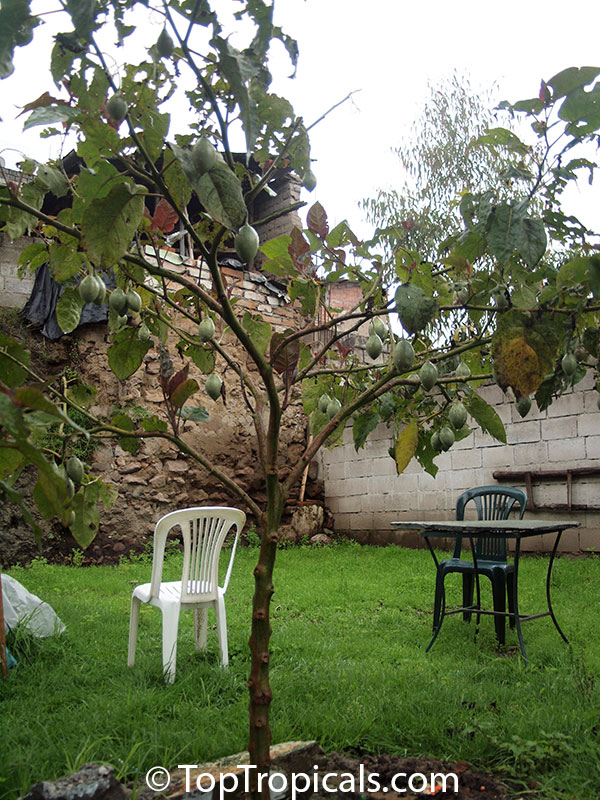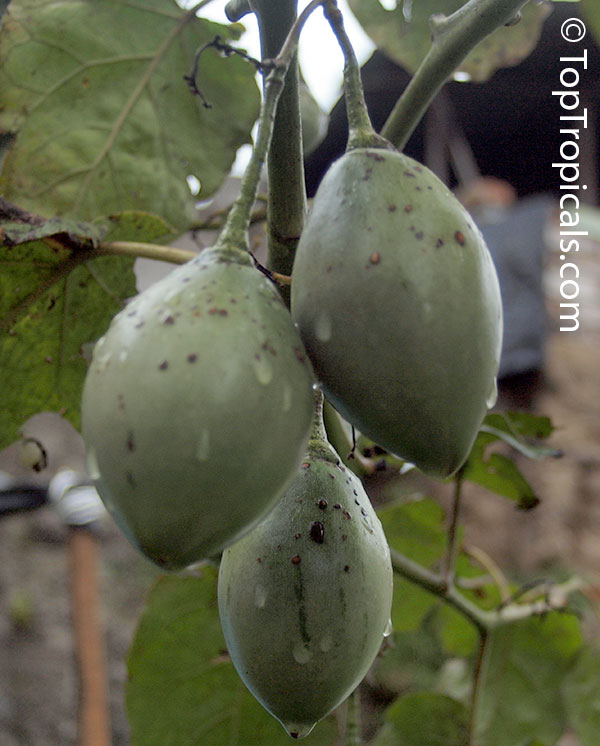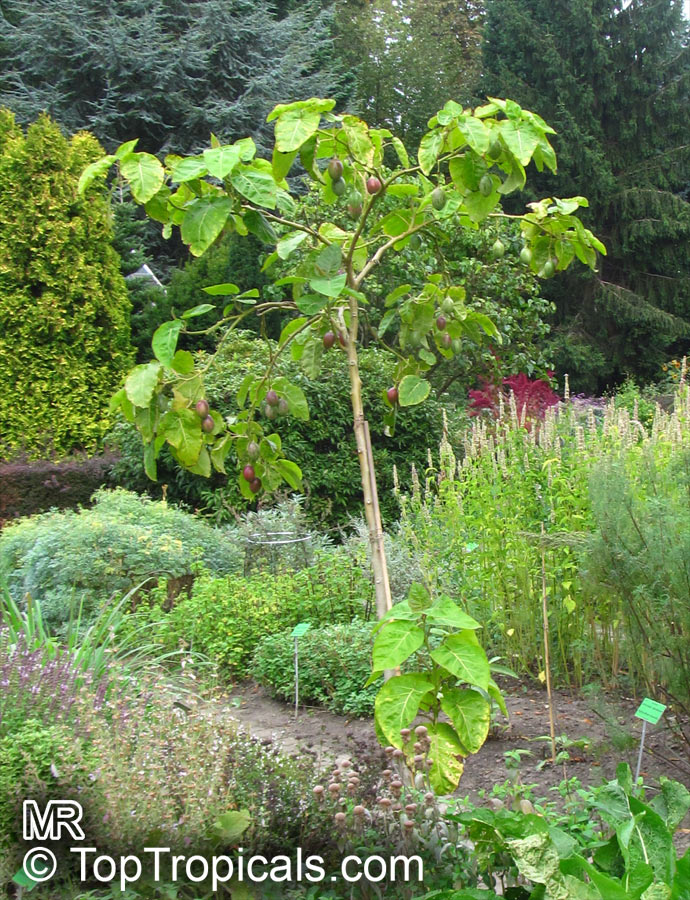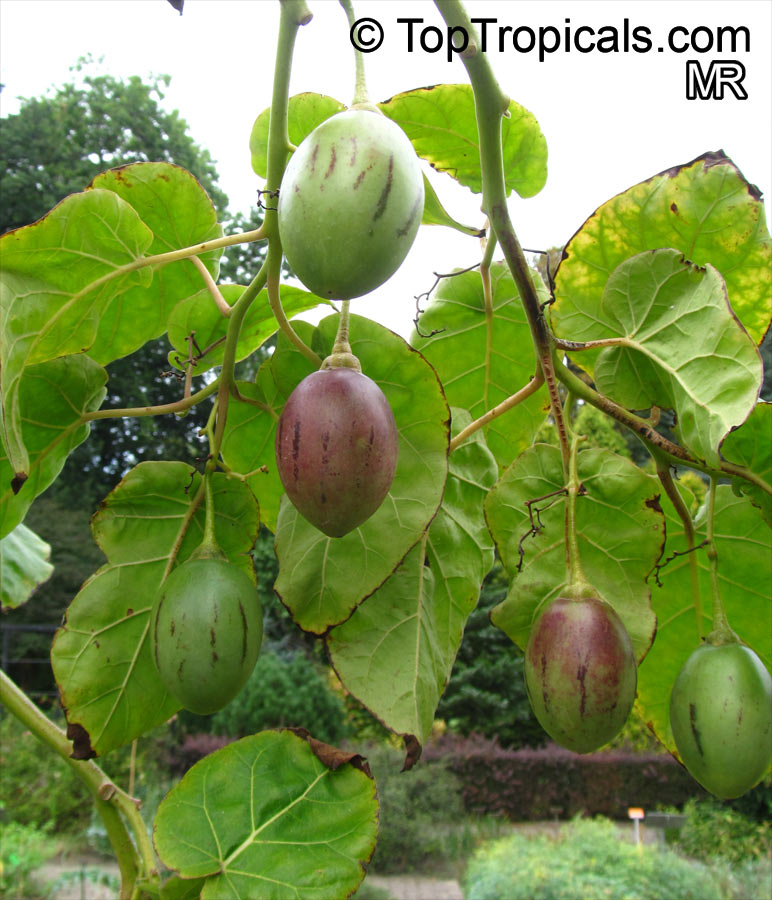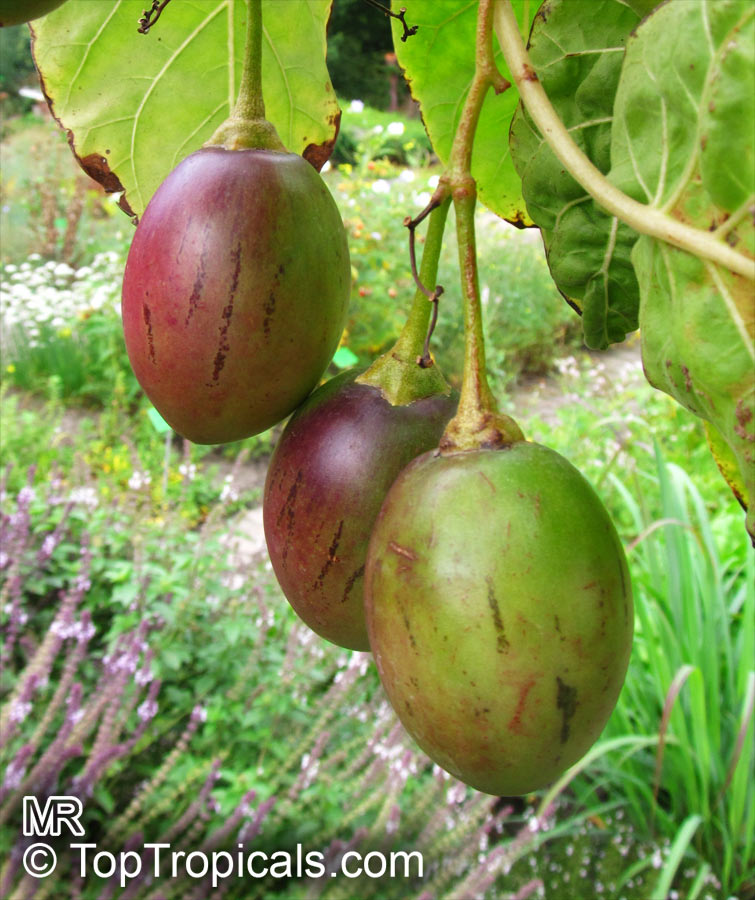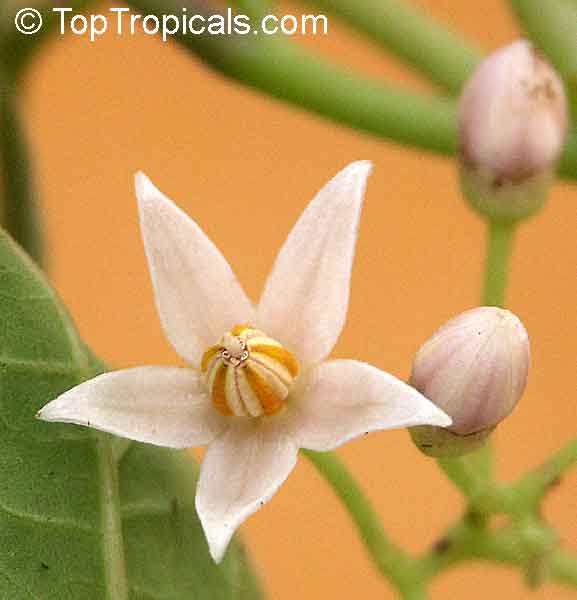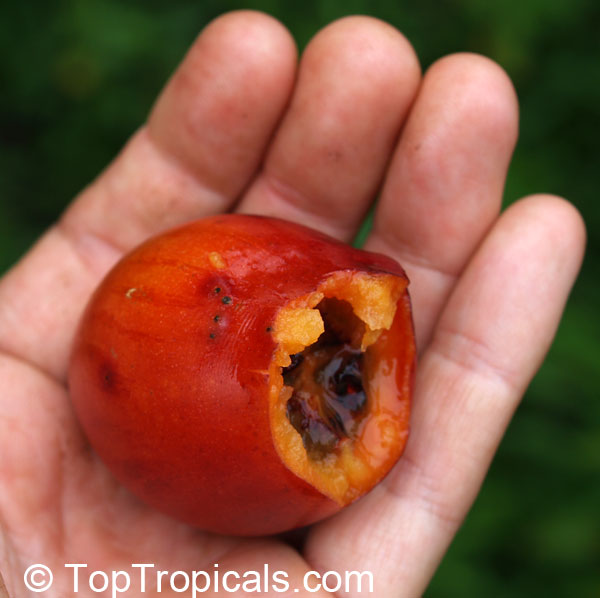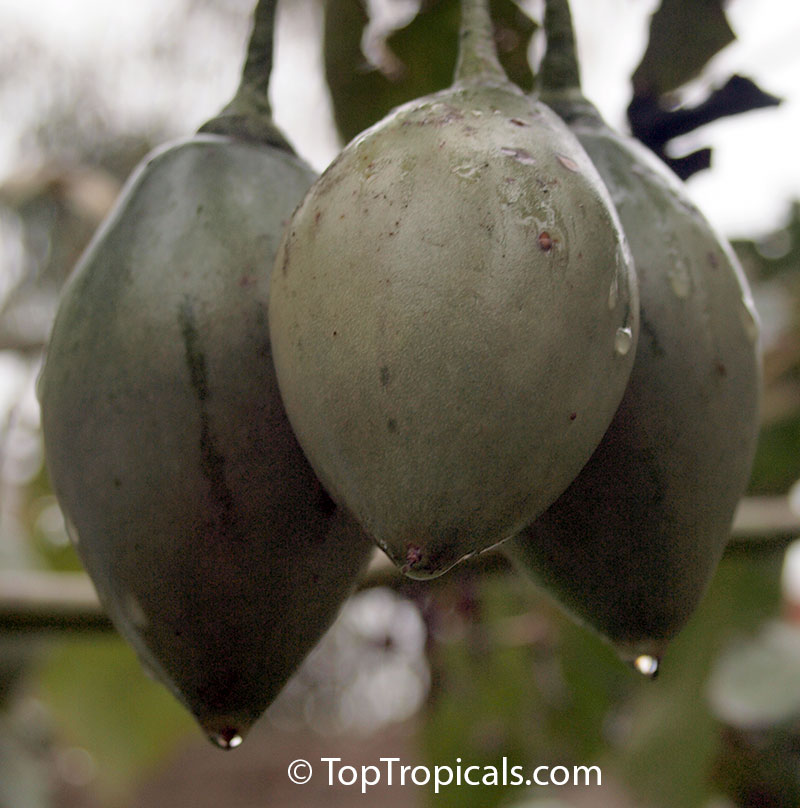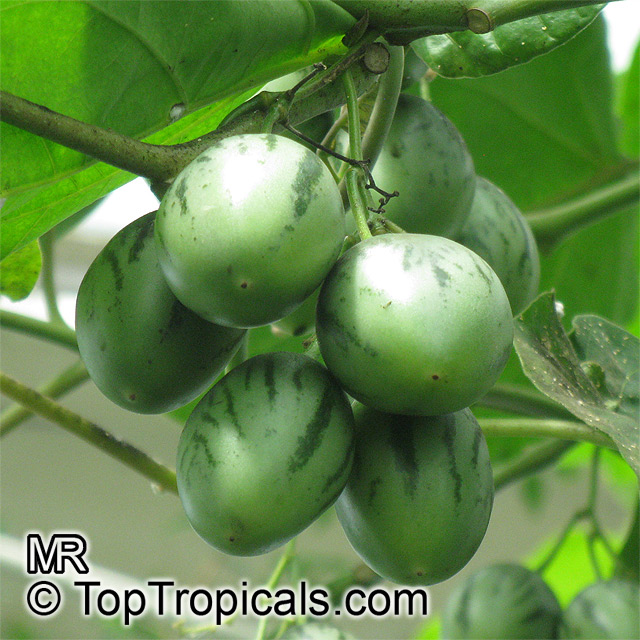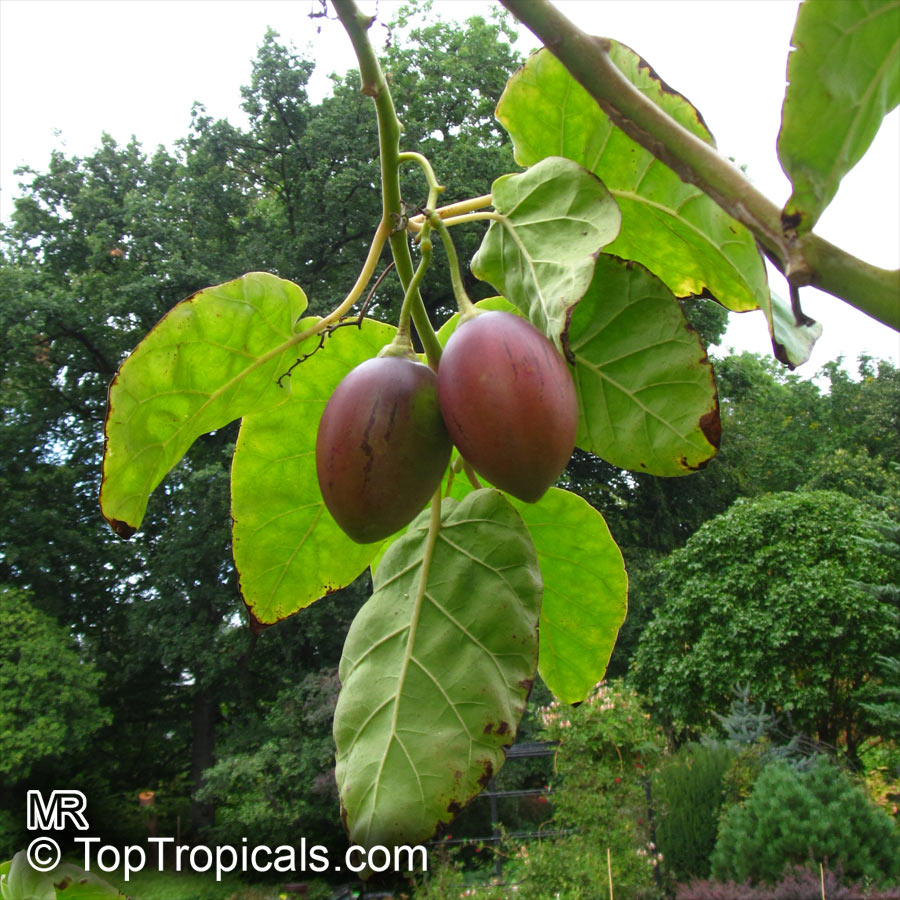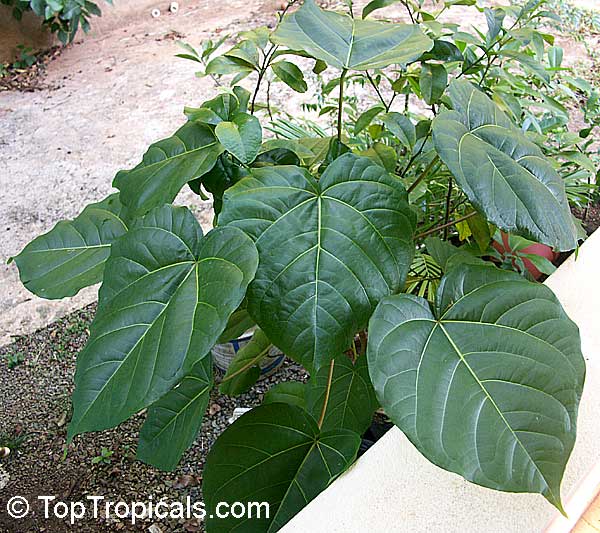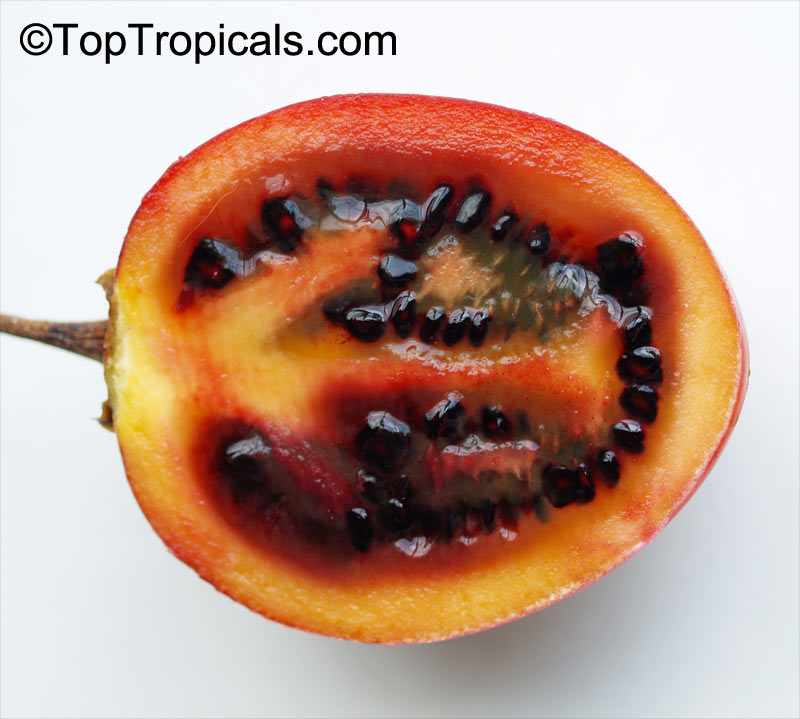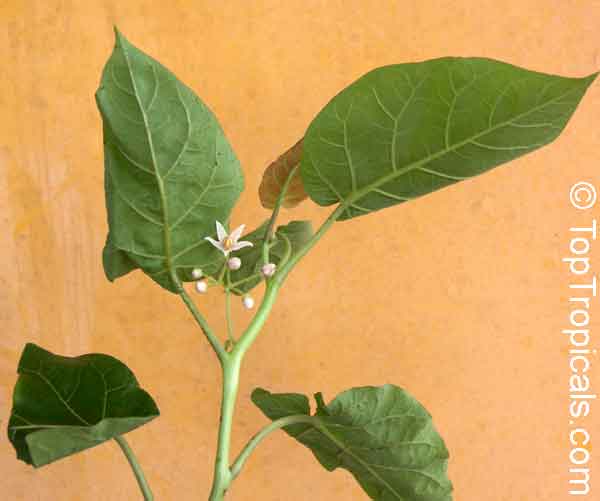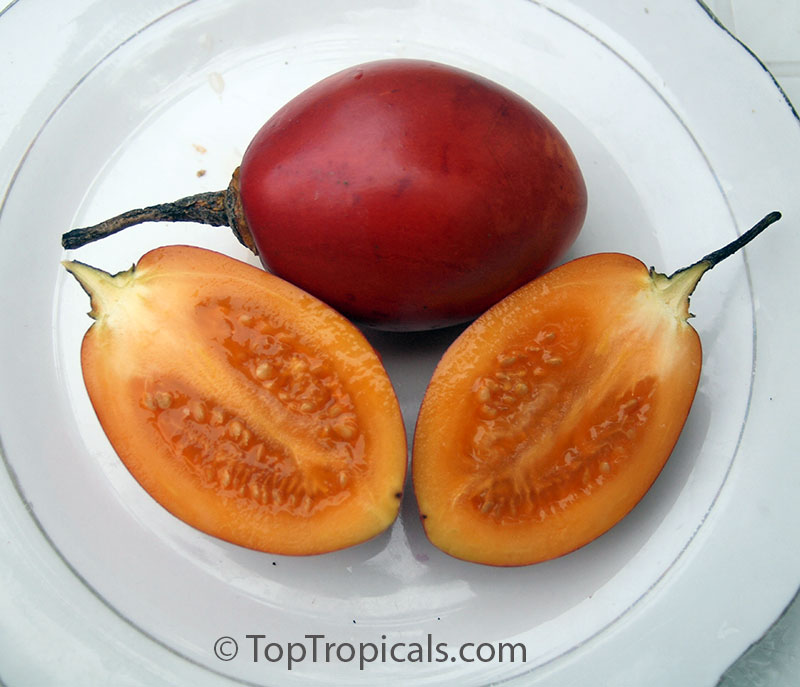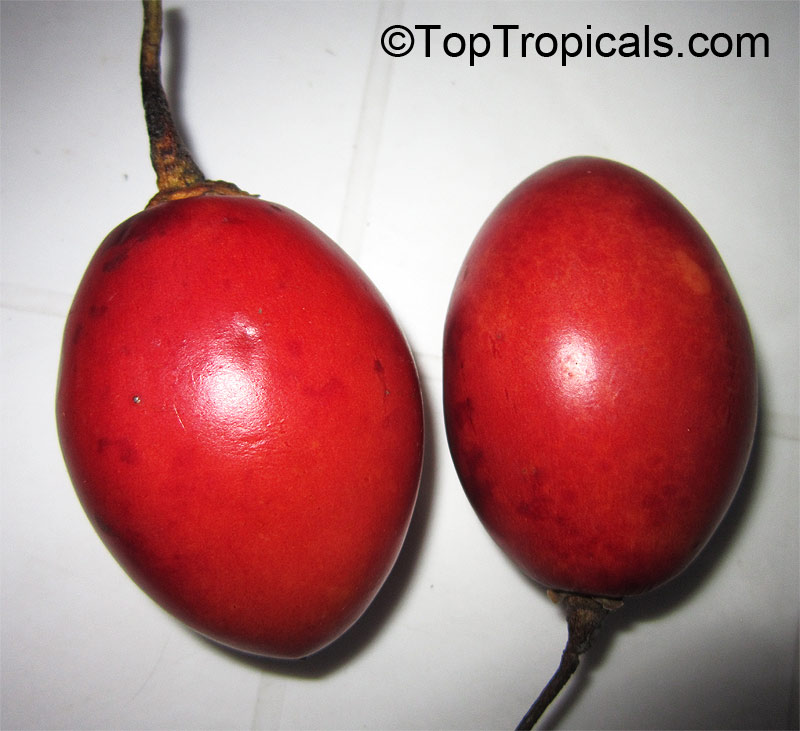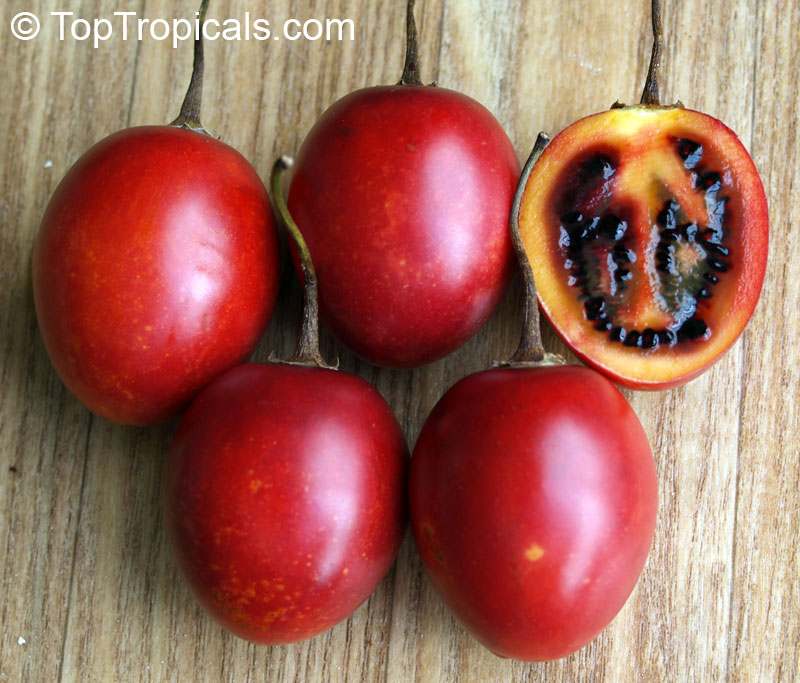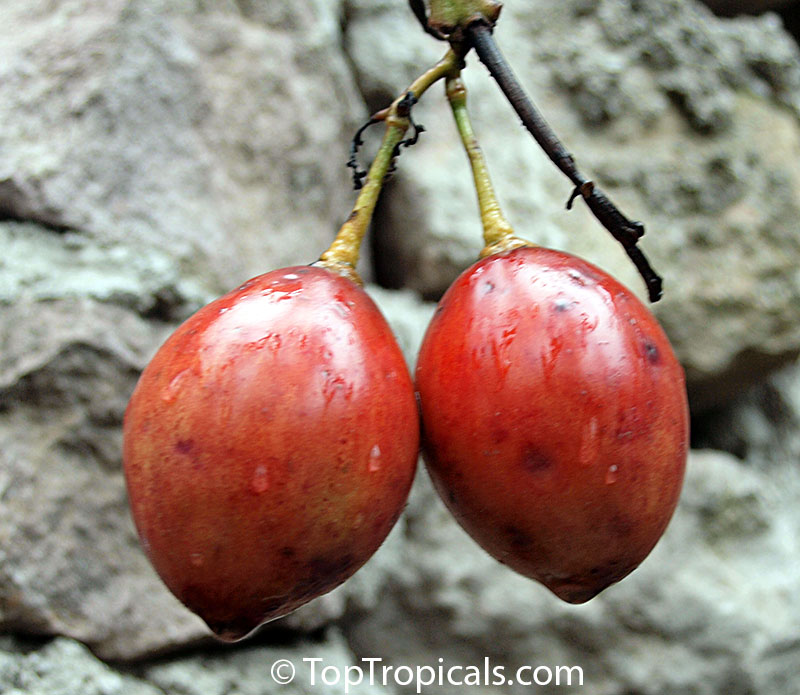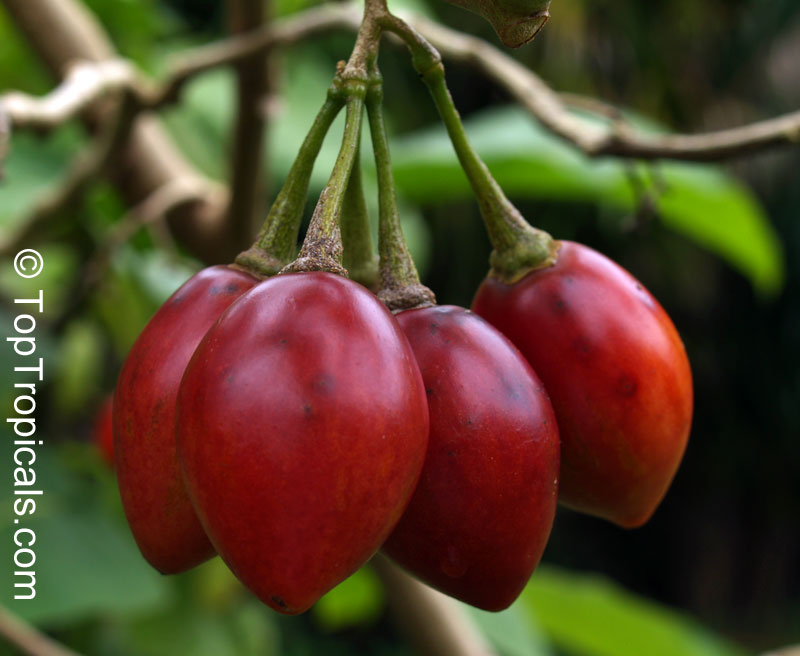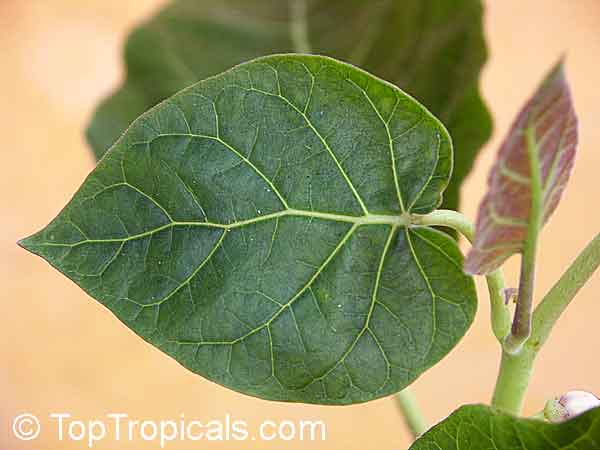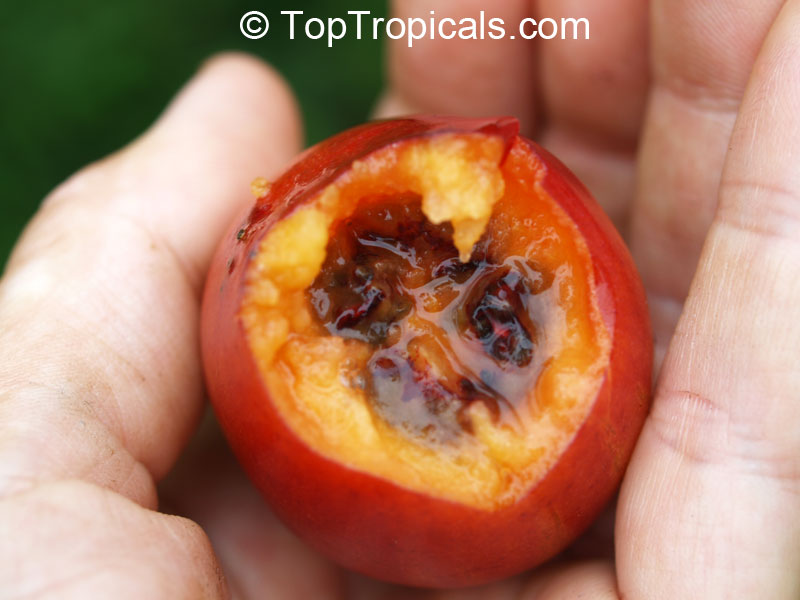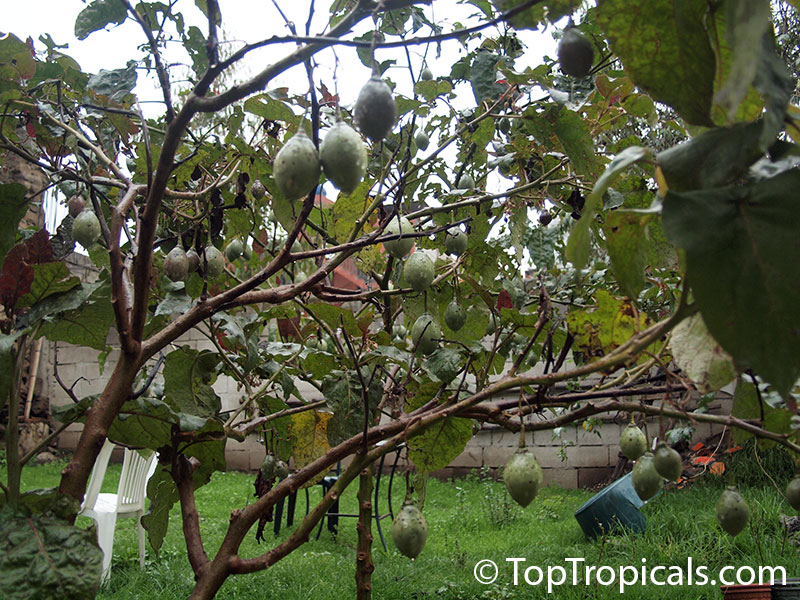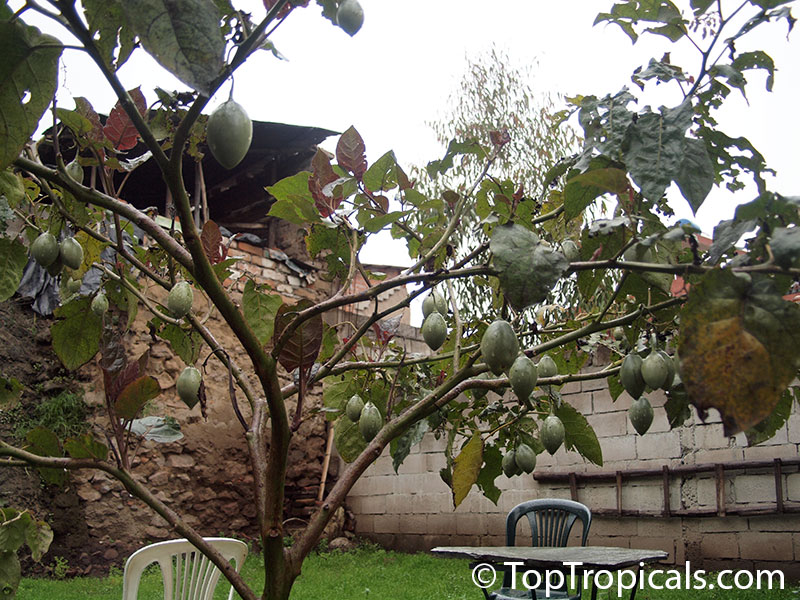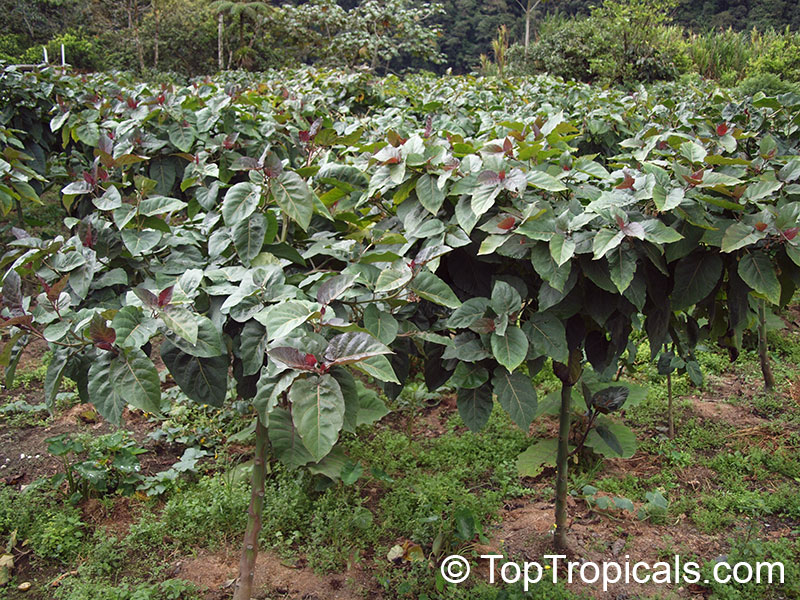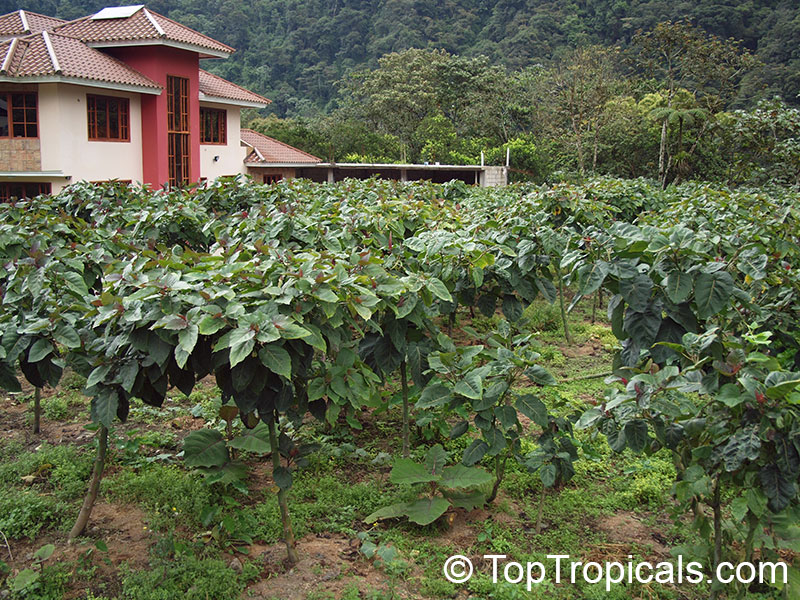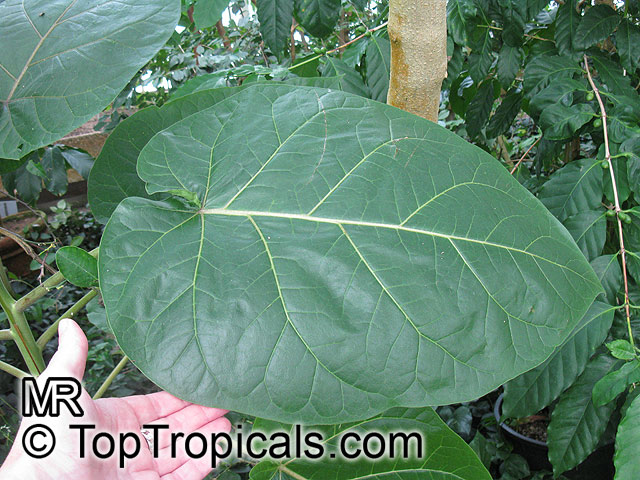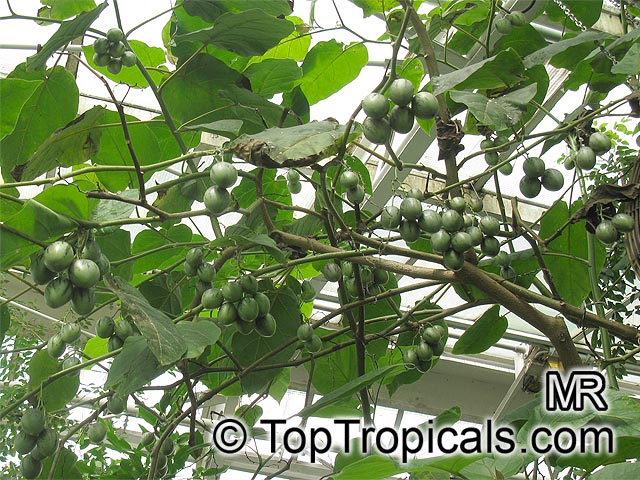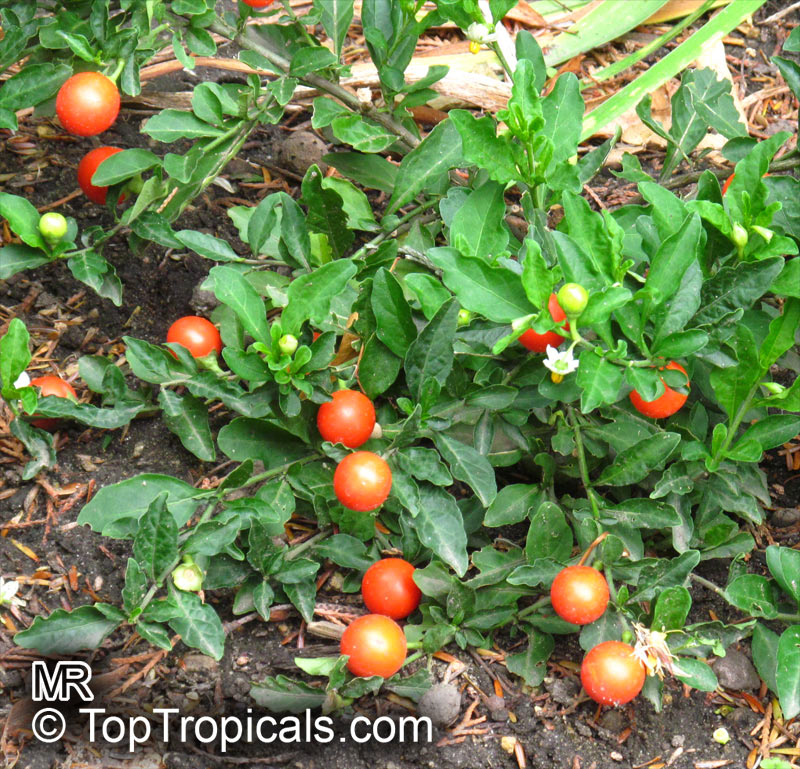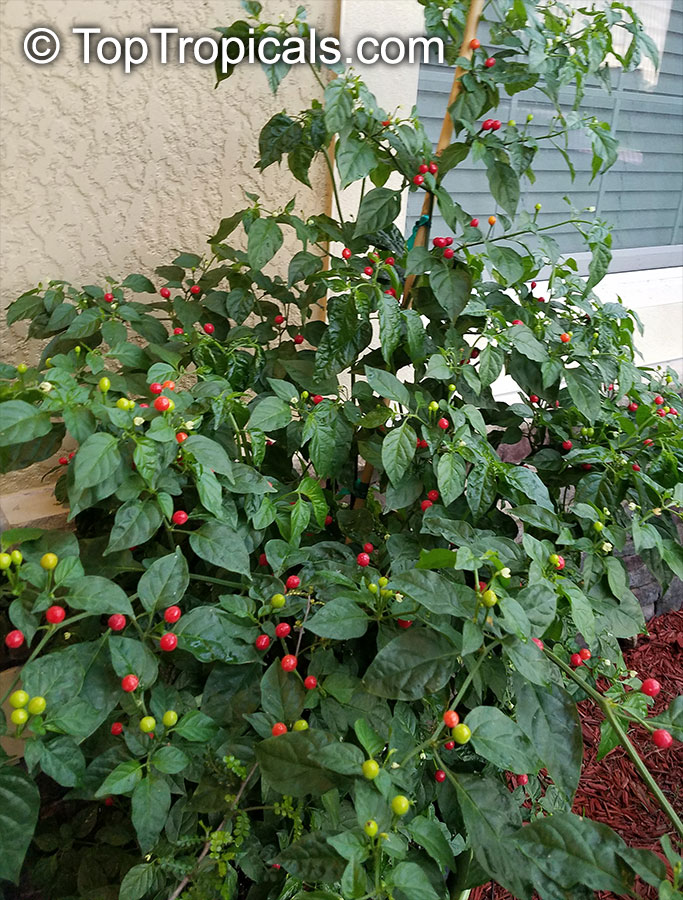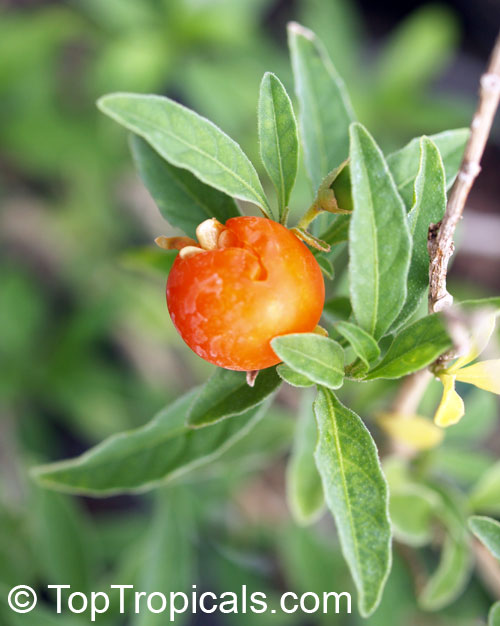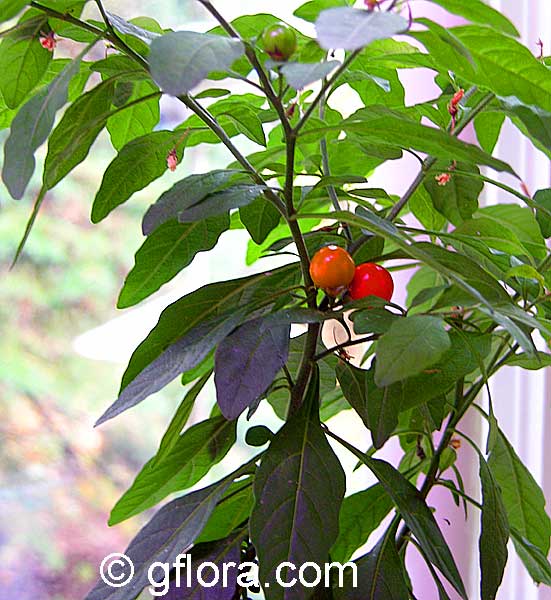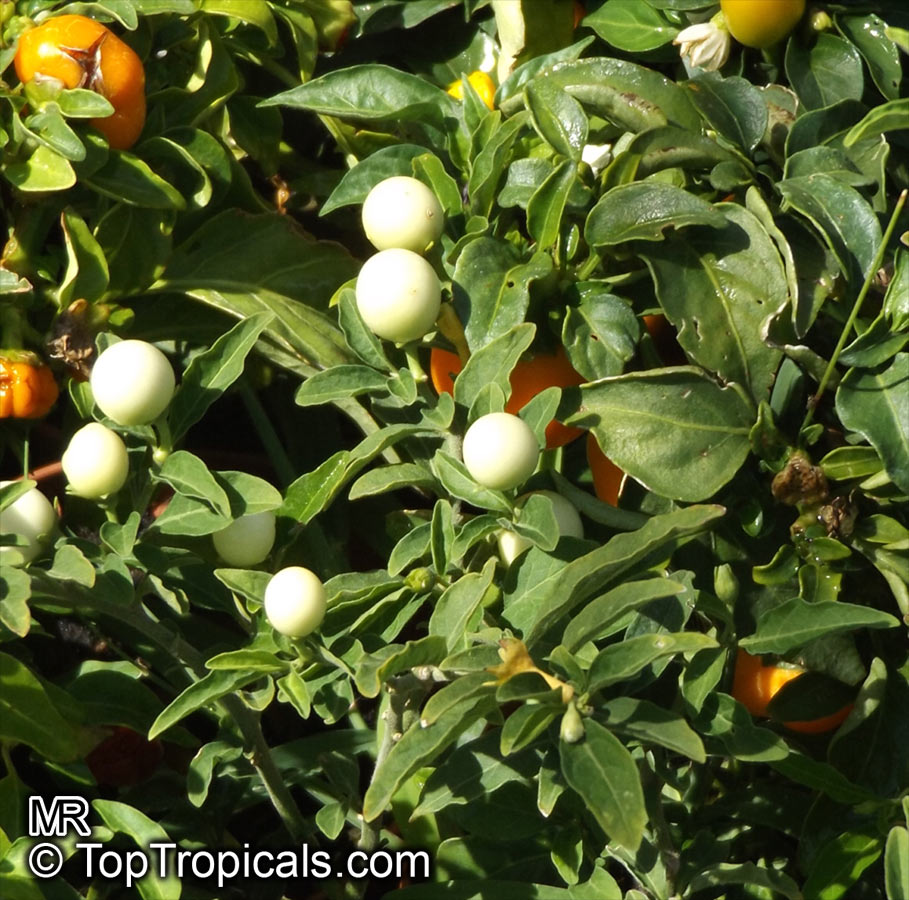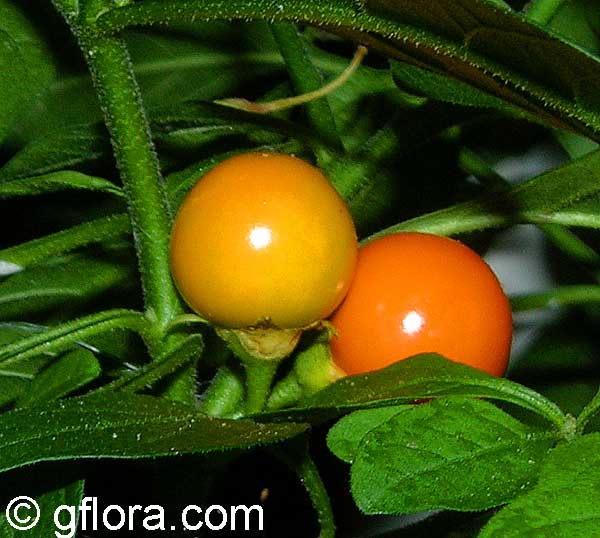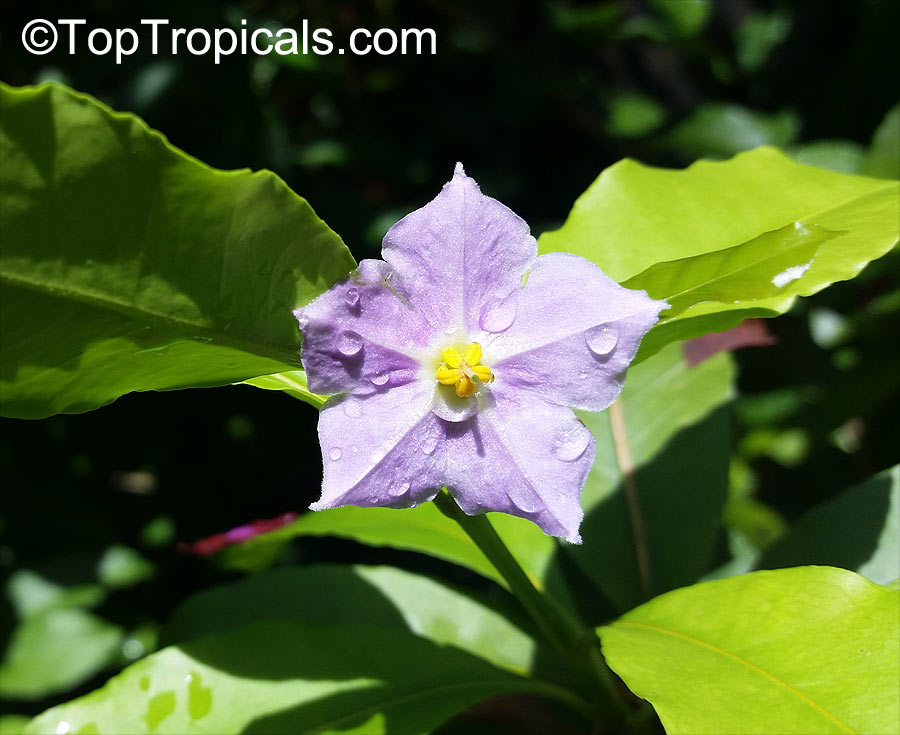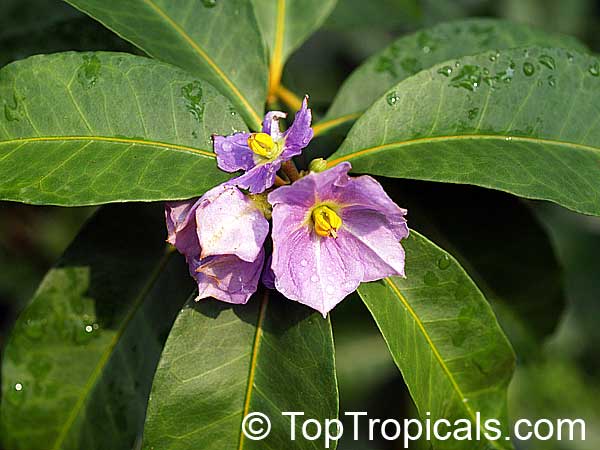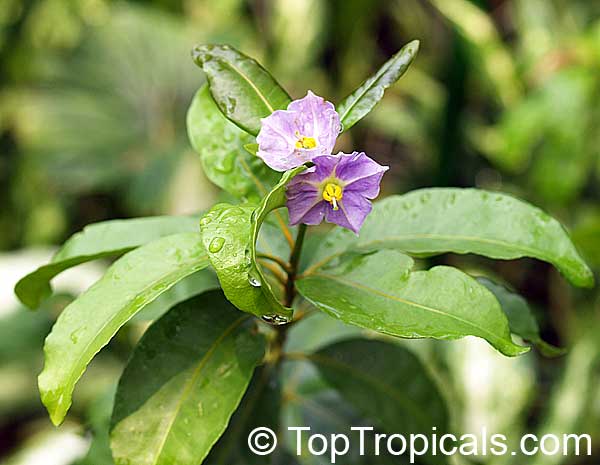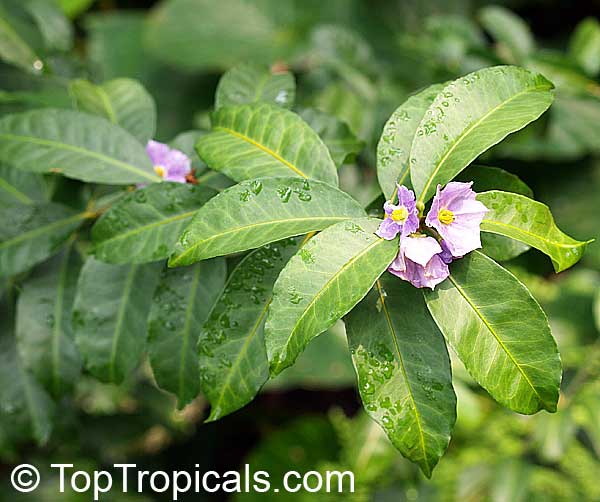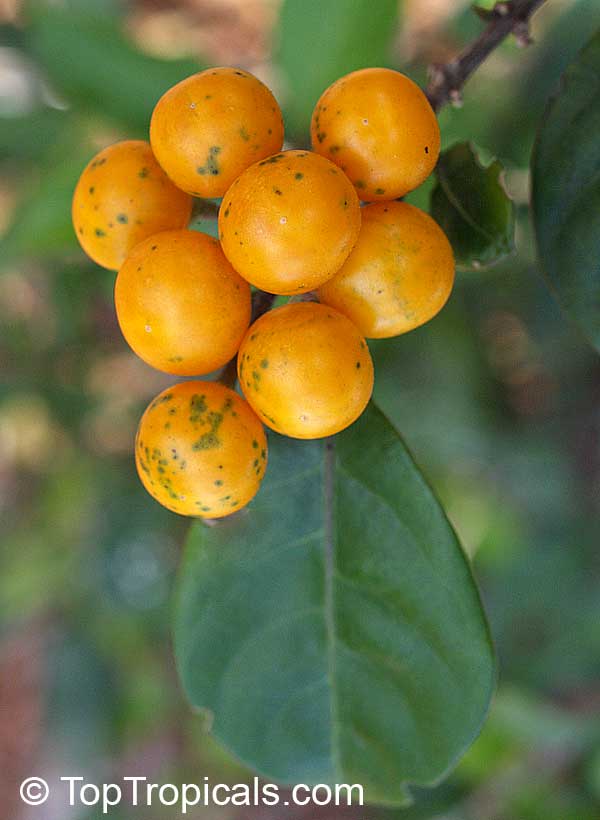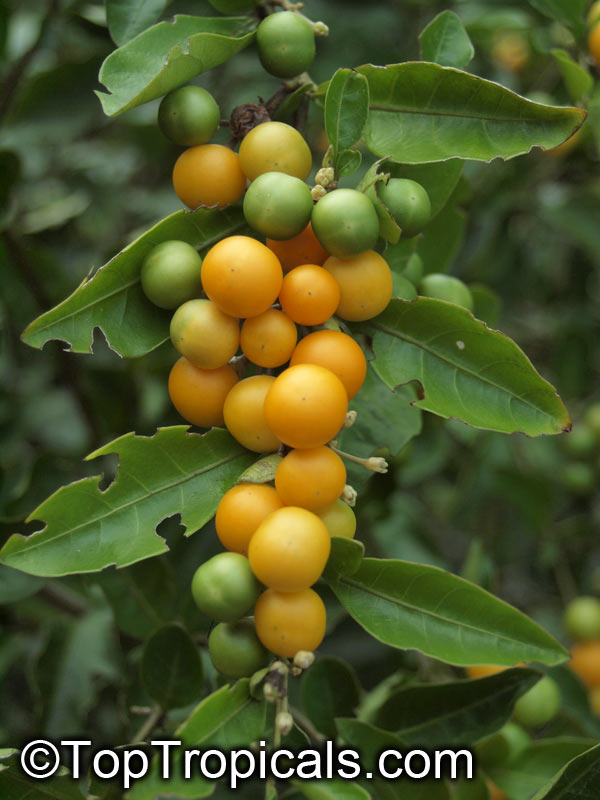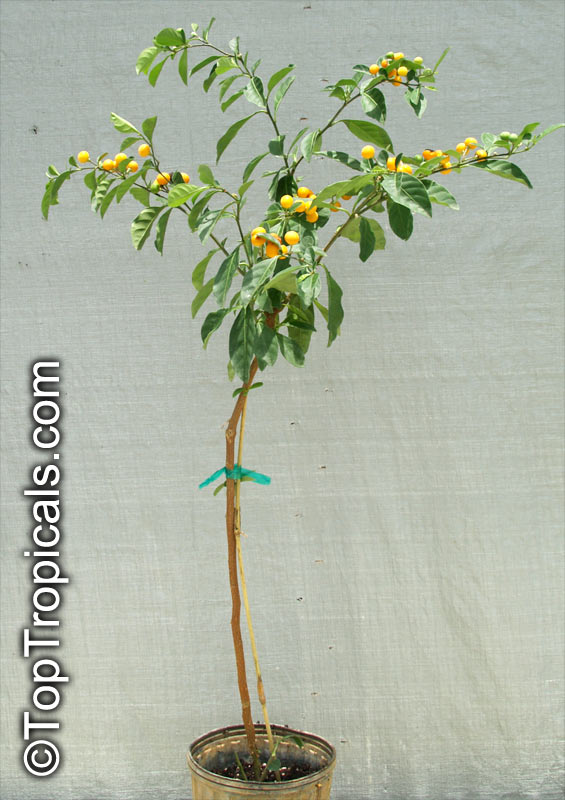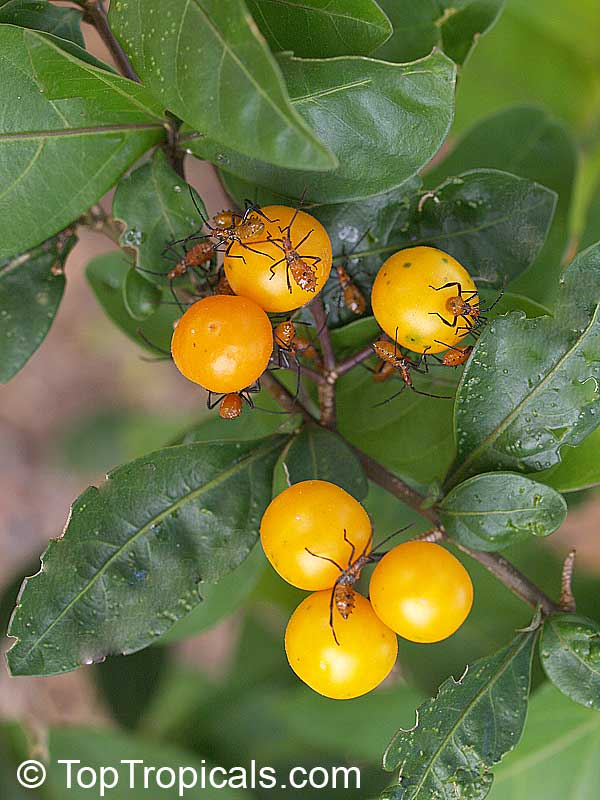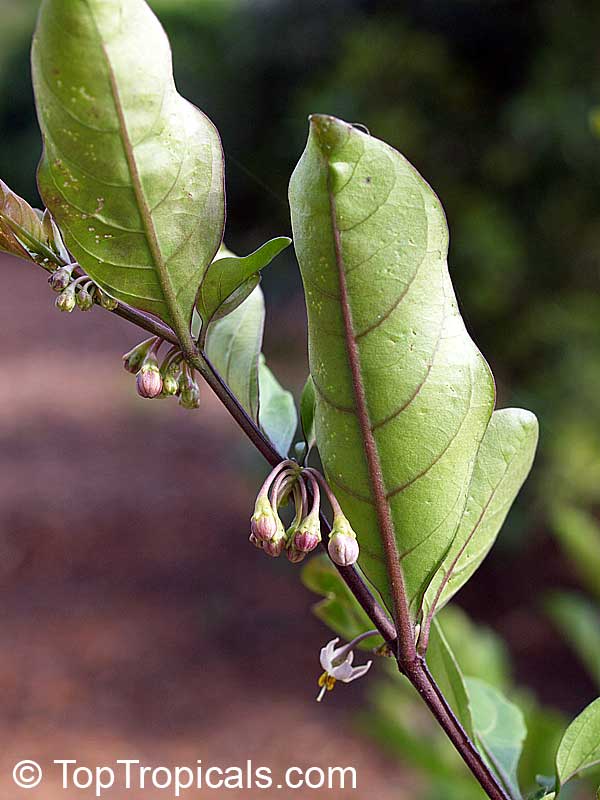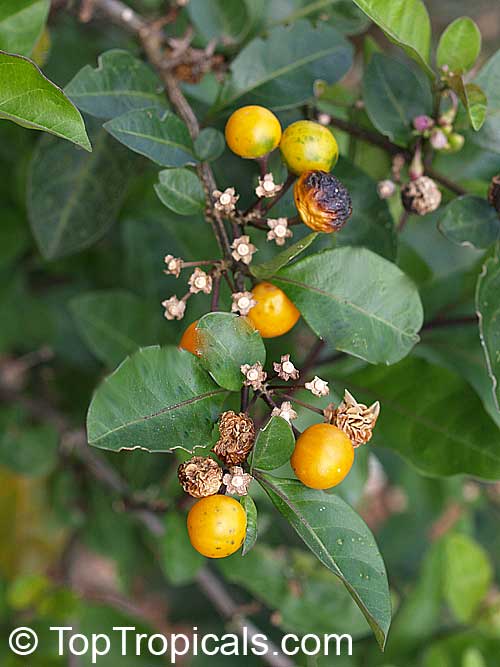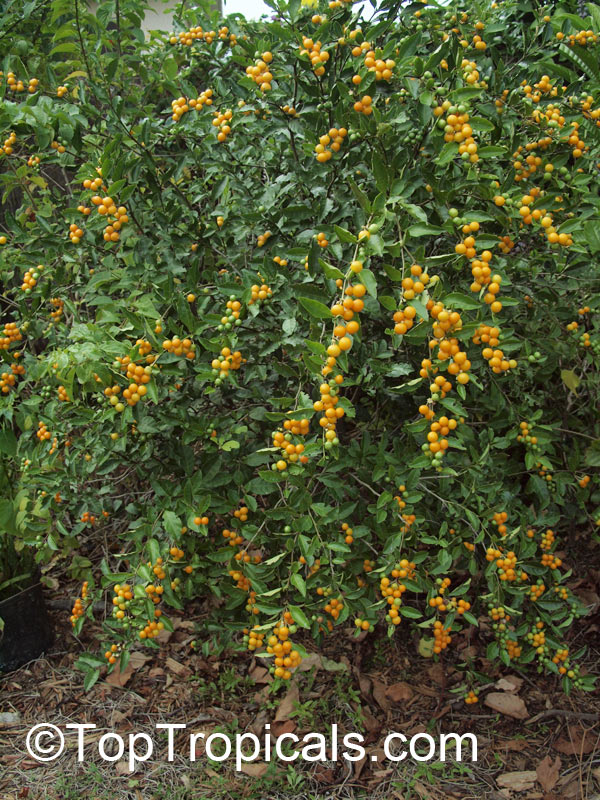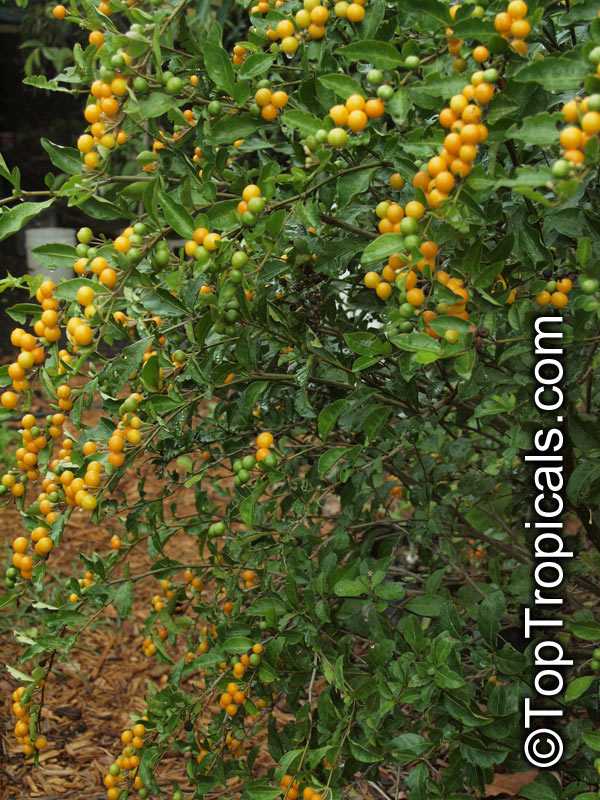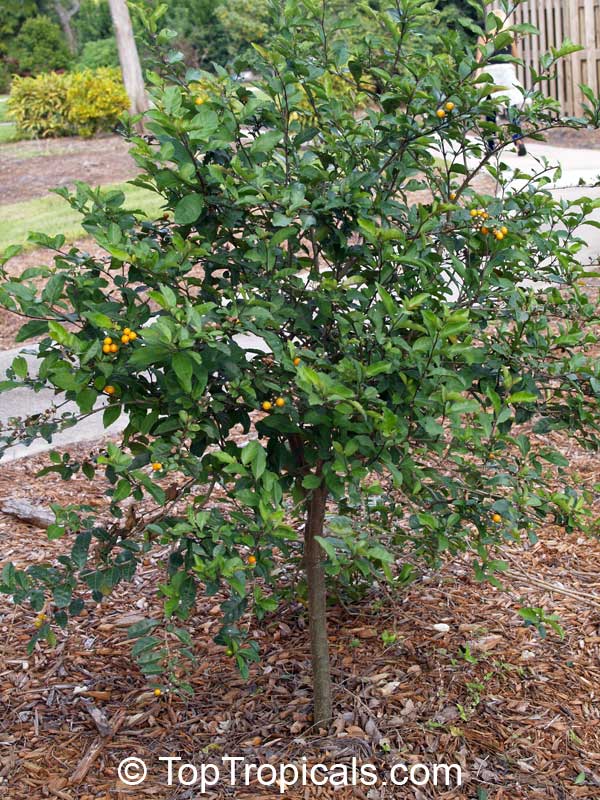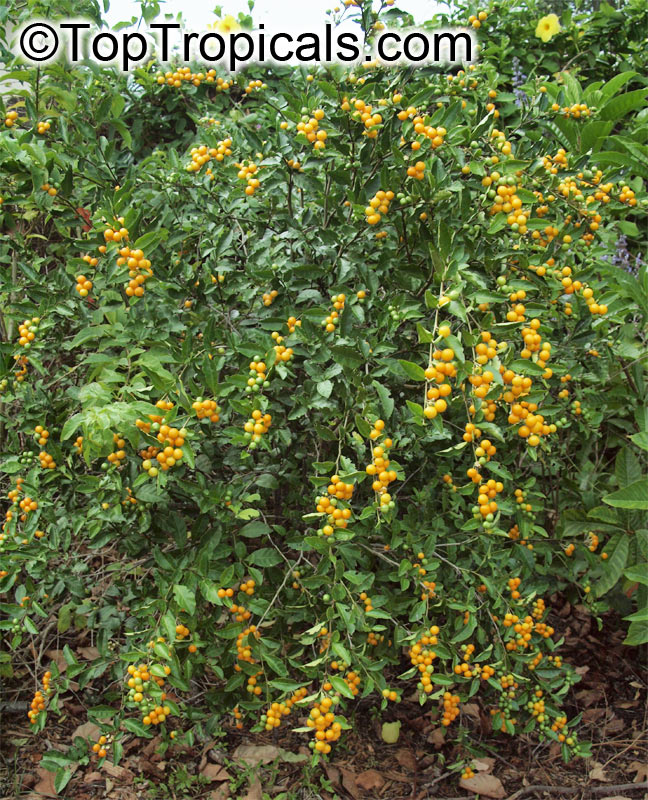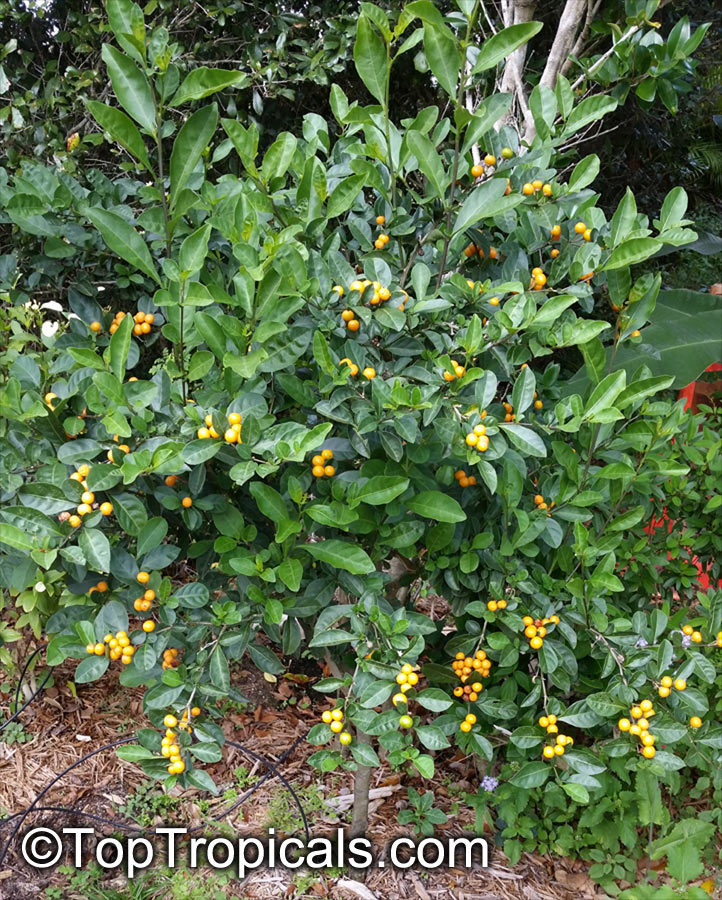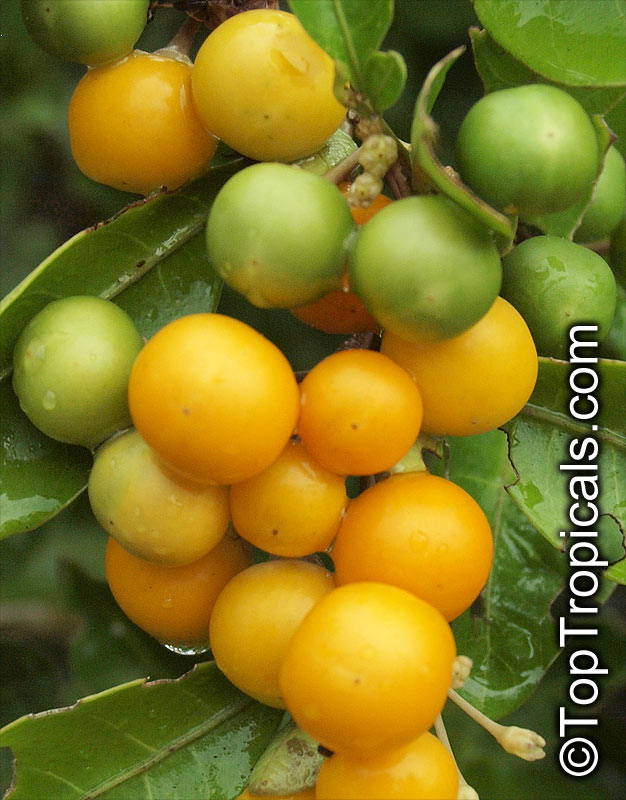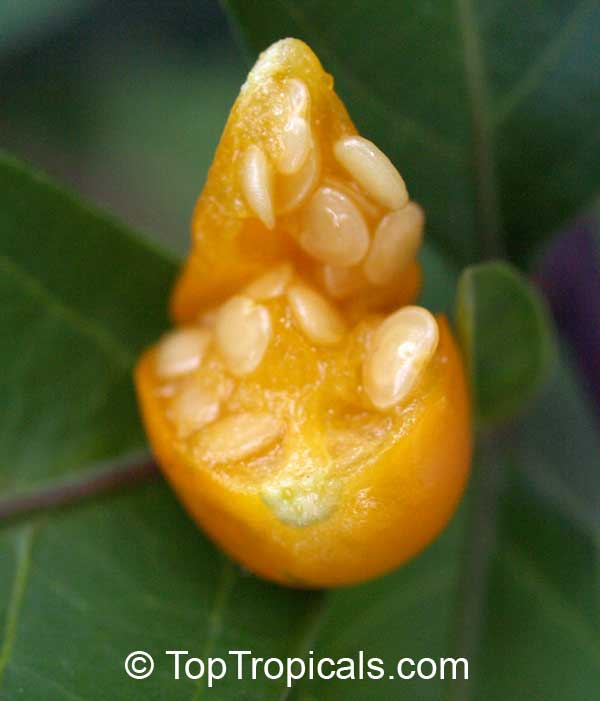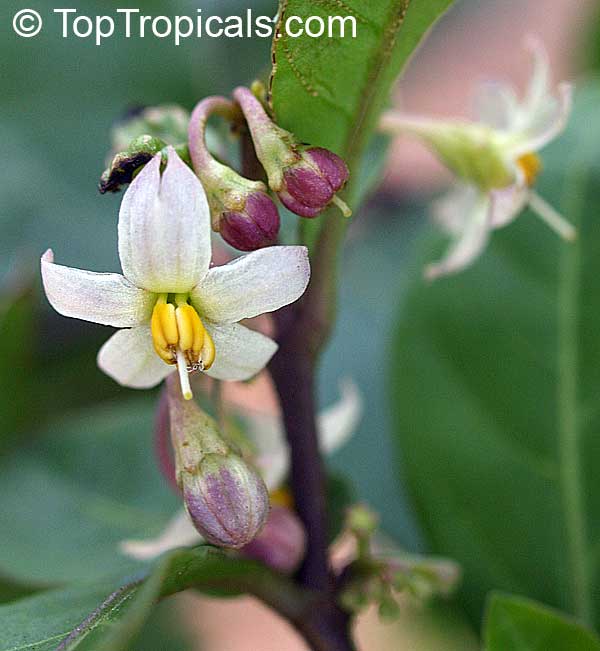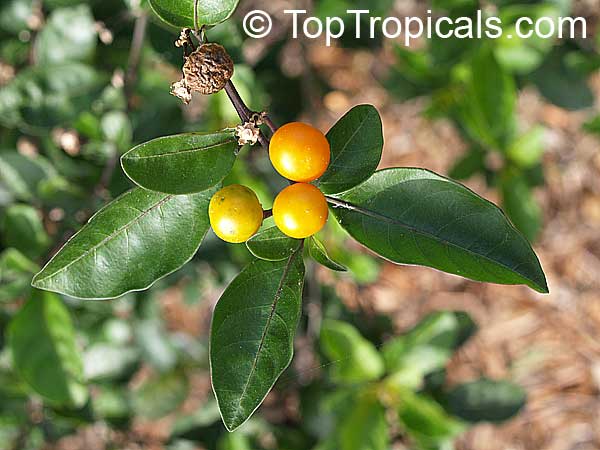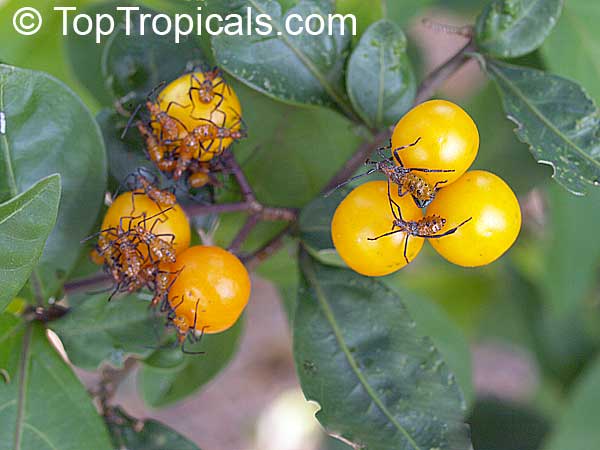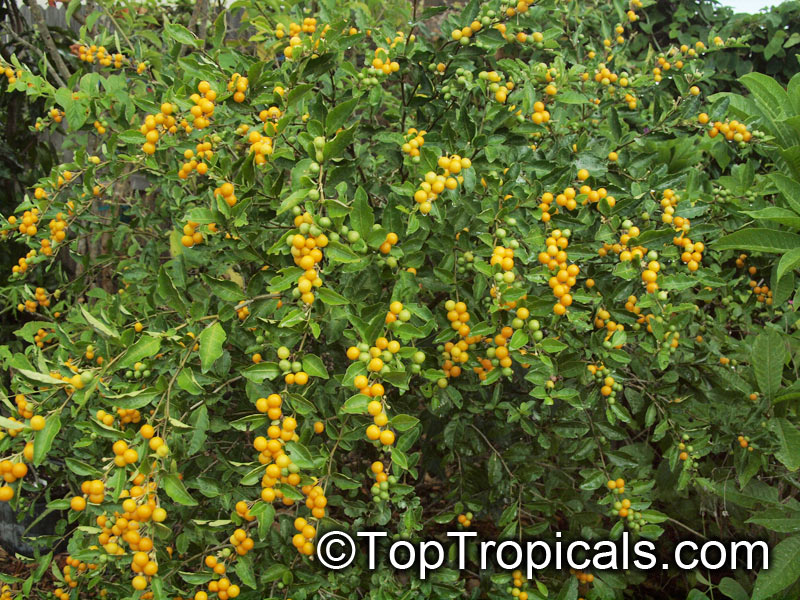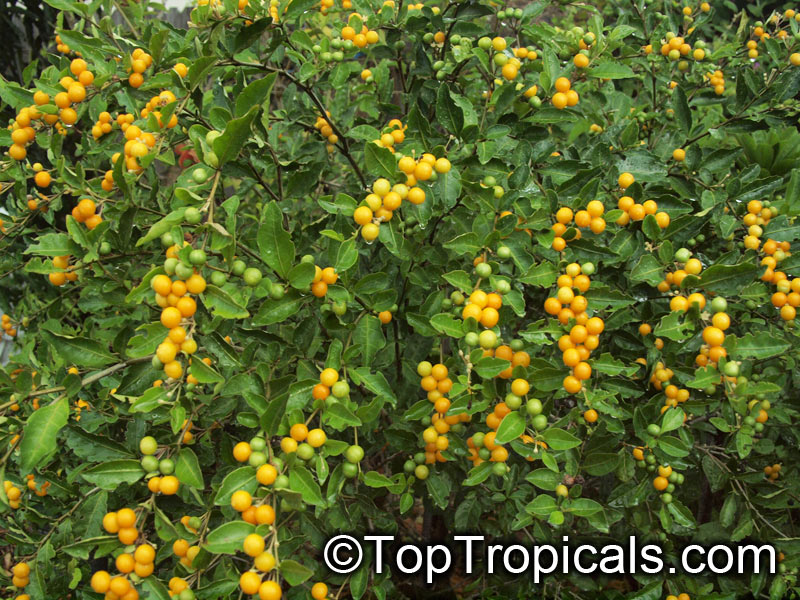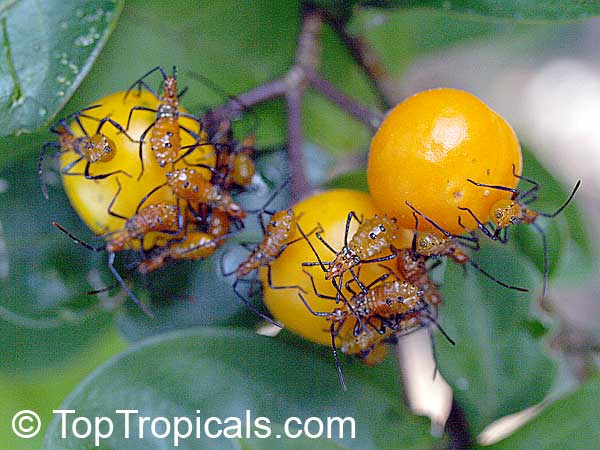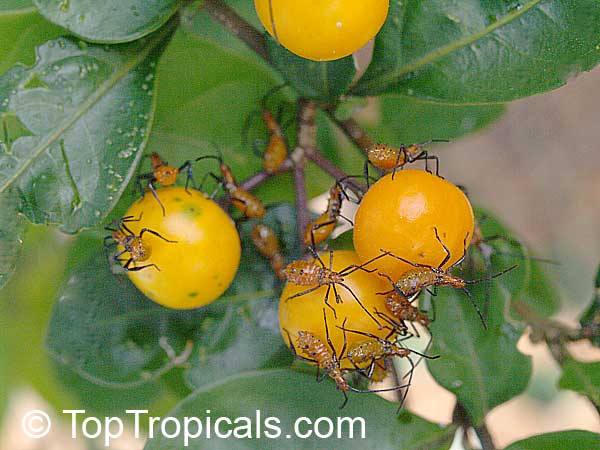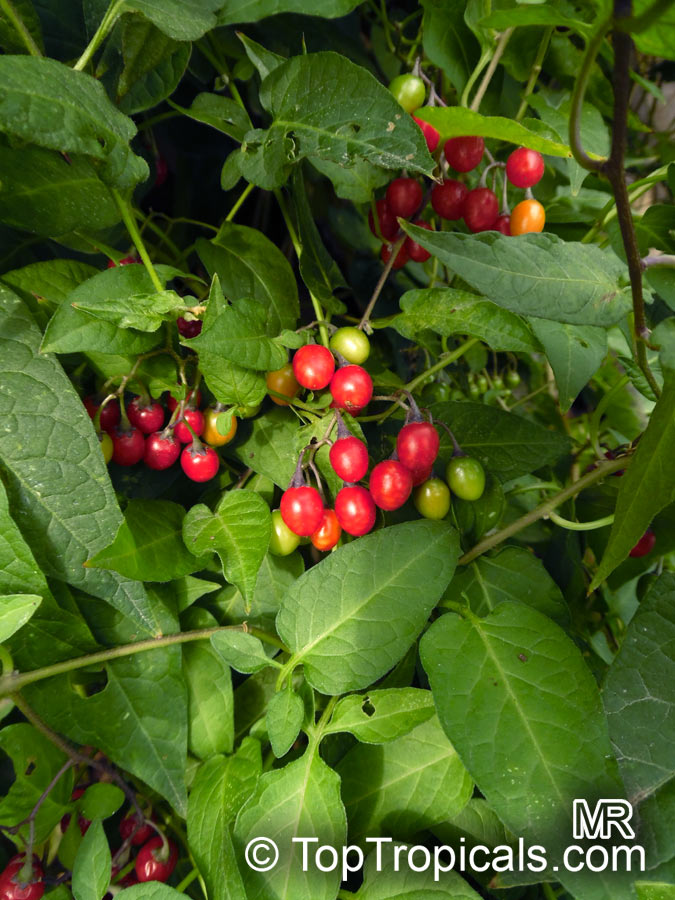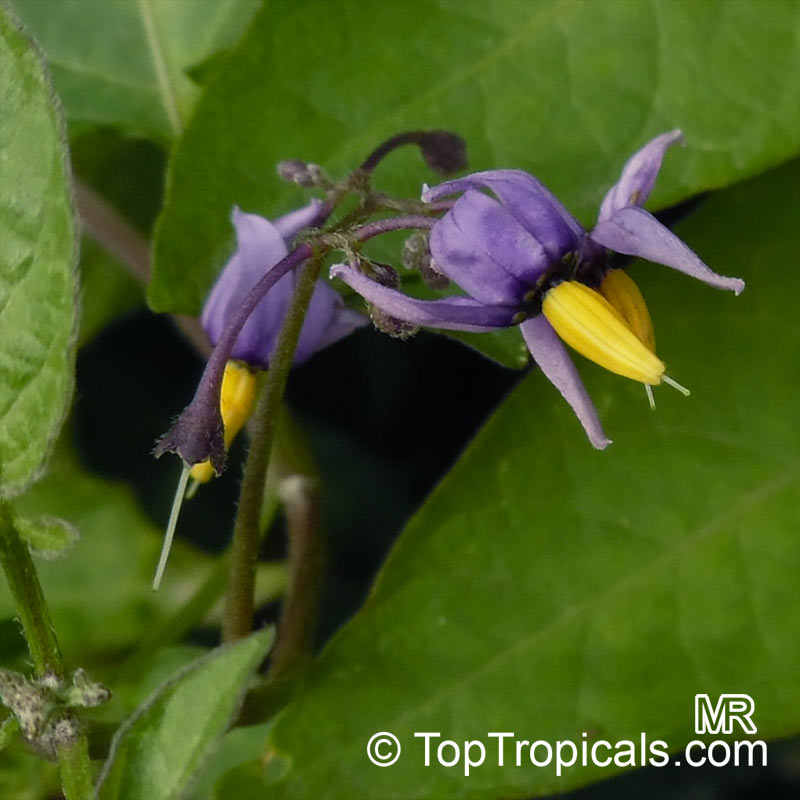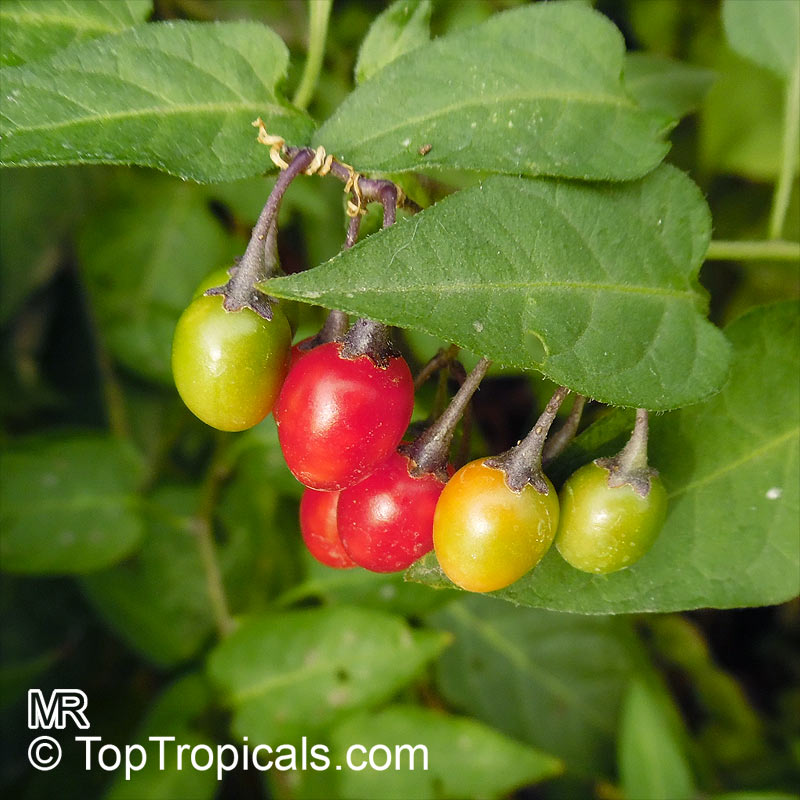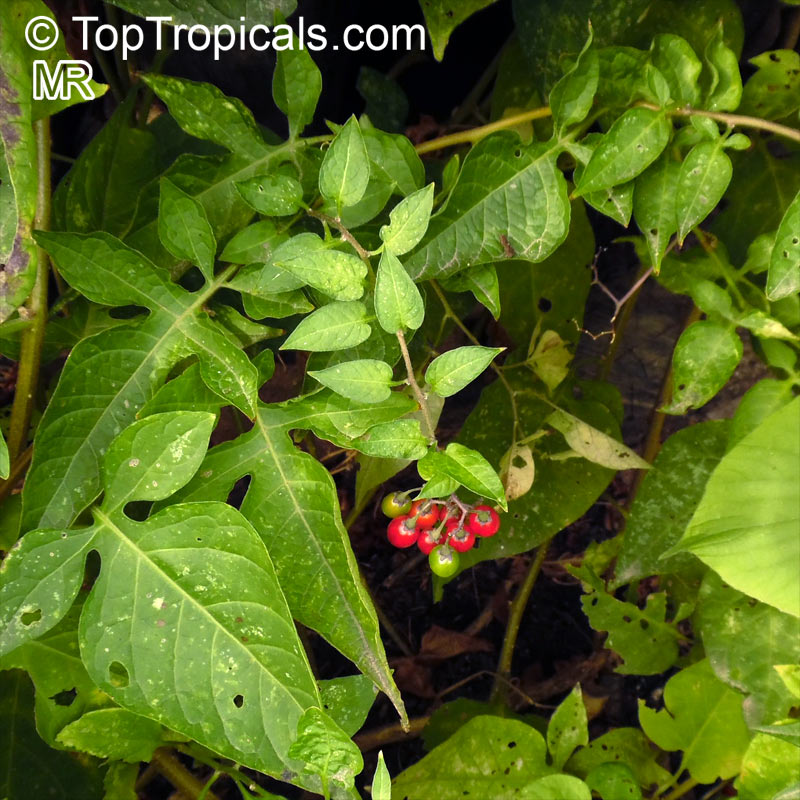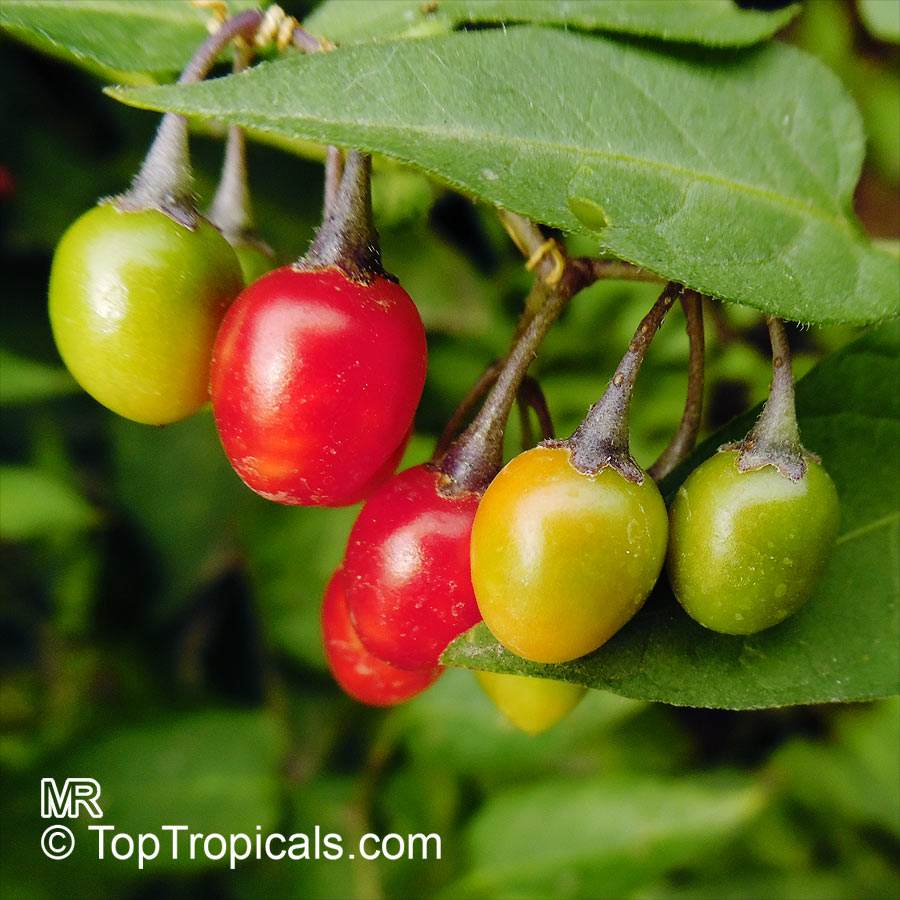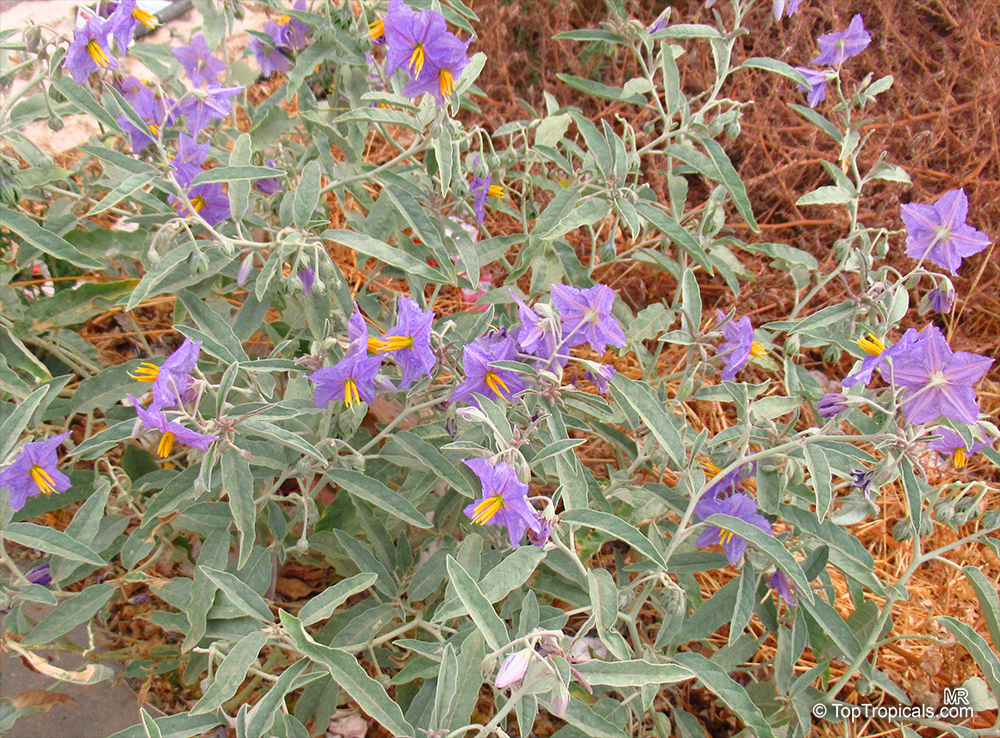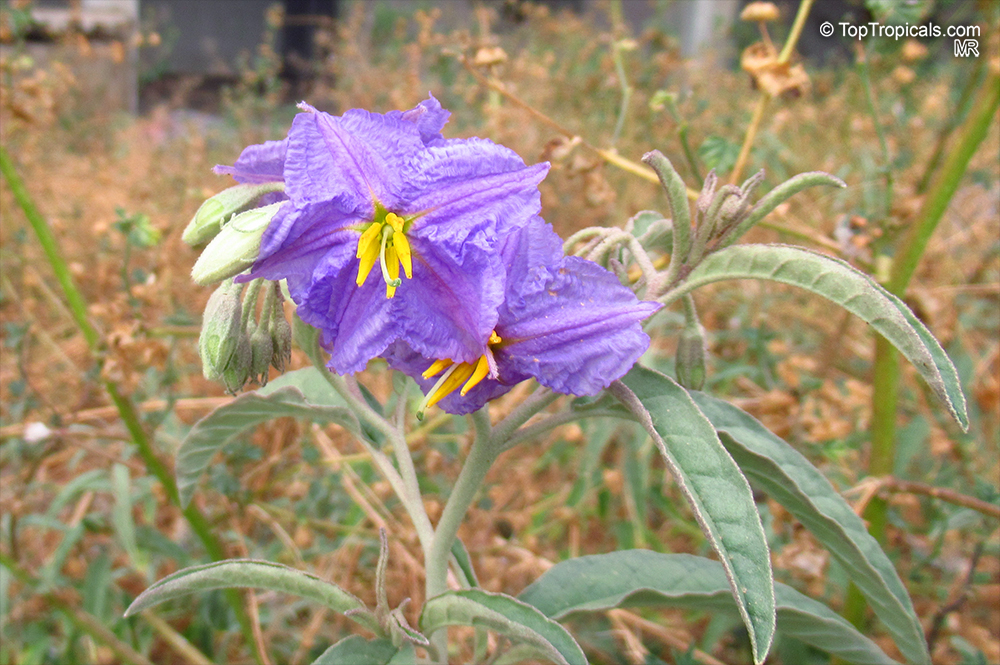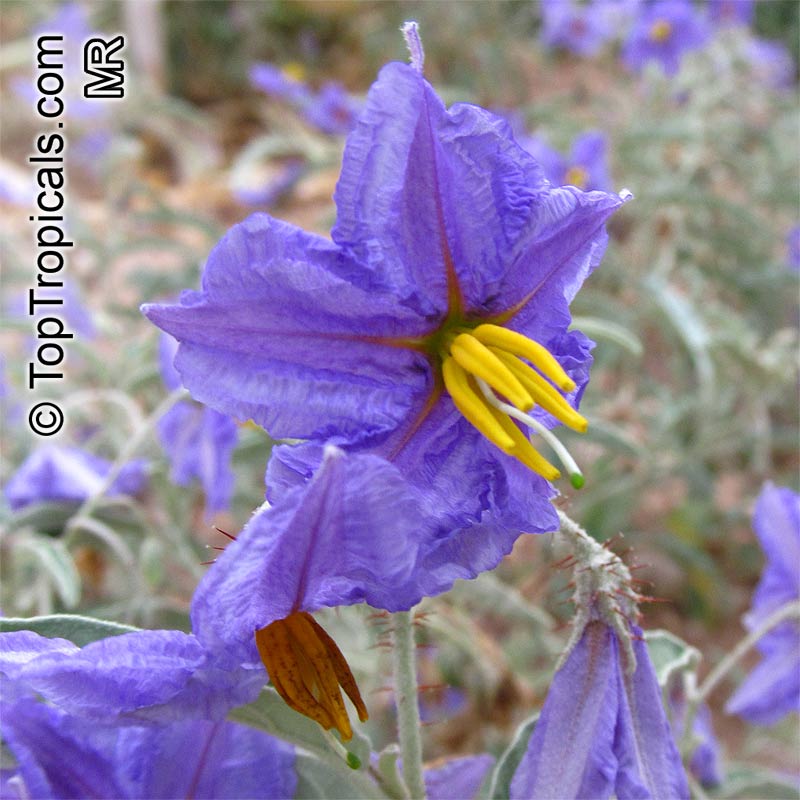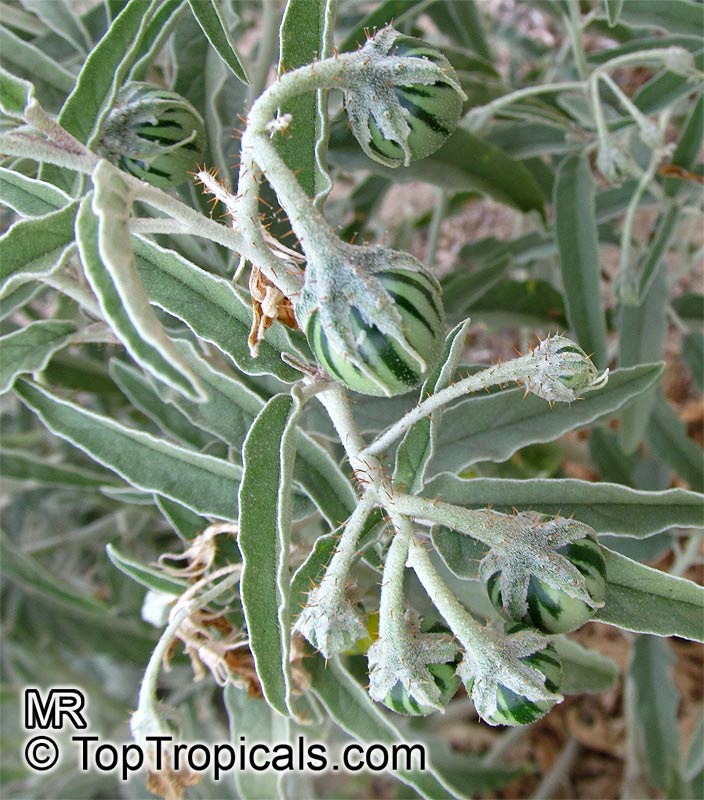Solanum - Plant Encyclopedia Results
Top Tropicals Plant Encyclopedia
| Number of plants found: 33 | Next | 
|
Go to page: | 1 | 2 | 3 | 4 |
Botanical names: Solanum bonariense, Solanum grandiflorum
Common name: Granadillo
Family: Solanaceae
Origin: South America







Botanical names: Solanum aculeatissimum, Solanum capsicoides
Common names: Cockroach berry, Indian Love Apple, Soda Apple, Devils Apple
Family: Solanaceae
Origin: South America







Solanum aculeatissimum, better known as Cockroach berry, is a small shrub native to South America. It produces a bear-like fruit with a tasty orange pulp, but the spiny or thorny nature of the leaves and stems make it quite an irritating plant to handle. But this small shrub of 2-5 feet in size is an ethnomedical plant, and it's also a fast-growing one at that.
When it comes to growing and caring for this plant, you only need to provide it full sun and moderate water, although they are surprisingly frost-tolerant. The additional advantage is that Cockroach berry is a low-maintenance and drought-resistant species, needing no extra or special care. It will also perform best in USDA Zone 9 - 11, but can be grown in colder climates if grown in a pot and provided with a bit of extra protection.
If you're living in areas where heavy rainfall is a common occurrence, be careful when planting this small shrub as it's known to be quite invasive. Due to its easy-to-spread nature, it's important to control it before it starts to overtake. Additionally, you'll need gloves on when handling these prickly plants, and it is recommended to wear thick clothing to protect your skin from its spines.
Overall, Solanum aculeatissimum is an interesting plant to grow, and due to its native status and invasive nature, it can be useful to both gardeners and households alike. Whether you grow it in the landscape or in a pot, it is sure to make a statement but just be sure to keep it in check and use gloves when handling!
Botanical name: Solanum atropurpureum
Common names: Malevolence, Purple Devil
Family: Solanaceae
Origin: South America








Solanum atropurpureum, otherwise known as Malevolence, is a large shrub native to South America. Growing 5-10 feet tall, this plant is well known for its bright yellow and orange flowers.
Malevolence is best suited to full sun, although it can tolerate some semi-shade. To maintain good health and achieve a mature size, it should be planted in moist, well-drained soil and given regular watering.
It is used in landscaping gardens and can be grown in USDA zones 9-11. In colder climates, growing Malevolence in containers is recommended and the shrub should be brought inside during periods of frost. Container-grown plants should be watered regularly to ensure soil remains damp and mulching should also be used to retain moisture.
While Malevolence offers a bright and cheerful appearance in any garden, it is also known for its spines and thorns, which can cause irritation when touched. The plant's fruits are also known for producing liquids that are highly irritating to the touch.
Malevolence is a great addition to many gardens, offering vibrance and height. Those planting it should be aware of its irritant properties and take necessary precautions when caring for it.
Botanical name: Solanum bahamense
Common name: Bahama Nightshade
Family: Solanaceae
Origin: West Indies






Solanum bahamense (Bahama nightshade) is a very versatile species of plant, ideal for a range of conditions. It is a fast-growing, evergreen large shrub, reaching heights of up to 10 feet tall. In mild climates, it will also form smaller plants of up to 5 feet in height. It can also be grown successfully in containers and as a smaller, short-lived perennial.
The best place to grow Solanum bahamense is in an area with full sun and semi-shade. It enjoys moderate water and soil that drains well. It is an attractive addition to any garden, with its bright clusters of blue, lavender, and purple flowers throughout the growing season. It is also drought tolerant, and can gracefully tolerate short periods of dryness.
When established, this plant is surprisingly cold hardy, surviving temperatures that drop to at least the 30s F. Solanum bahamense is best grown in USDA zones 9-11. For colder regions, it can be grown in a pot, making sure to protect it from prolonged action of cold temperatures.
In its native region, Solanum bahamense can form large stands in disturbed soils and scrubs. But it's versatile nature makes it a great choice for many different places and habitats. It is an attractive addition to any garden and can be grown successfully in a range of climates and conditions.
Botanical names: Solanum betaceum, Cyphomandra crassicaulis, Cyphomandra betacea, Pionandra betacea, Solanum crassifolium
Common names: Tamarillo, Tree Tomato, Tomate Arbol
Family: Solanaceae
Origin: Andes mountain of Peru






The Solanum betaceum, more commonly known as the Tamarillo, is a small tree of 10 to 20 feet that is native to the Andes mountain in Peru. This tree prefers semi-shade and requires the soil to remain moist. It produces white or off-white flowers that can be slightly irritating to the skin, though these give way to the edible fruits. A mature plant is cold hardy and can survive temperatures at least as low as the 30s Fahrenheit for a short time, and is suitable for USDA Grow Zones 9 to 11.
The ripe fruits of the Solanum betaceum can range from orange to red to purple, depending on the variety, and are similar in size and shape to a hen's egg. The flavor of the fruit can vary from tree to tree, but generally it is juicy and sub-acid, and often likened to the garden tomato. These fruits can be eaten raw or cooked, though they should have their seeds and skin removed before cooking. The unripe fruits are slightly toxic.
The Solanum betaceum tree can produce hundreds of fruits on one mature tree in the right conditions. These fruits are an excellent source of vitamins and minerals and offer a range of benefits to those who eat them, including improved eye health and a boost in energy. Eating tamarillos on a regular basis can also help to reduce the risk of heart disease, can boost the immune system, and can help to promote healthy skin.
When growing Solanum betaceum in cold regions, the plant should be kept in a pot and brought indoors during the winter months. This will help to keep it safe from the harsh winter temperatures and will ensure that the tree can survive until the following growing season.
Botanical name: Solanum capsicastrum
Common names: Winter Cherry, False Jerusalem Cherry, Christmas Cherry
Family: Solanaceae
Origin: South America






Winter cherries (Solanum capsicastrum) are popular winter bedding in pots or window boxes that offer colorful foliage throughout winter. This low-maintenance perennial will reward you with neat little shrubs in a sheltered border.
Starting from midsummer, small white blooms dot the shrub, but the real show begins when tiny fruits the size of cherries start to emerge. These fruits can range from green, to yellow, to orange, and eventually to a deep vibrant red.
False Jerusalem Cherry is commonly grown as an ornamental plant indoors or out, and can reach heights of up to five feet. It thrives in full or partial shade and makes an impact when displayed en masse in containers and window boxes.
While this beautiful shrub is relatively easy to care for, potential gardeners should note that the fruits are toxic and not to be eaten. Water moderately, with a low-nitrogen fertilizer used occasionally to encourage fruit growth. Pruning away dead woody stems and wilted flowers is needed to keep the plant in optimal health.
Botanical name: Solanum conocarpum
Common name: Marron Bacoba
Family: Solanaceae
Origin: Virgin Islands






Rare plant native only to the U.S. Virgin Islands, growing in seasonally dry, coastal habitat. It is limited to the island of St. John, where there are approximately 190 plants living in the wild. Solanum conocarpum has very large, conical berries that are green at maturity.
Botanical name: Solanum diphyllum
Common name: Twoleaf nightshade
Family: Solanaceae
Origin: Mexico, Central America









A perennial woody shrub, can be shaped into a small standard tree. Leaves are 1-2", dark green and shiny/glossy, come in unequal pairs: one is large and elliptic, the other small and rounded. The drooping white flowers have five recurved petals and stamens with large yellow anthers. The flowers are pollinated by wasps, bees, and flies-the vibration of the wings causes the anthers to release the pollen. The many-seeded berries ripen to yellow-orange. They are very sweet and juicy. The fruit attract sweet-loving insects and birds. Birds eat the berries and are the primary dispersers of the seeds.
This plant is listed as poisonous (like many plants of Solanaceae Family), so it is unknown if the fruit is harmless to humans. In Mexico, the plant is used medicinally as a calming remedy.
It is cultivated in China and Taiwan as an ornamental and for hedges. Can become invasive in favorable conditions.
Botanical name: Solanum dulcamara
Common names: Bittersweet Nightshade, Climbing Nightshade
Family: Solanaceae
Origin: Europe, Asia









Solanum dulcamara or Bittersweet Nightshade is native to Europe, Asia and parts of the United States and hardy in USDA Zone 5 -9. This semi-woody, herbaceous perennial vine grows from 1 to 4 meters high and spreads by crawling over other plants. If given suitable support, this deciduous climber can extend to about 4 m high. The leaves are alternate and ovate, slender pointed and have a greyish green color. The flowers of this plant have five pointed petals, which can be seen in shades of lavender, purple and blue. These flowers attract butterflies and hummingbirds in the summer and are followed by clusters of red berries.
For growing and caring for this plant, it should be placed in full sun, but can tolerate partial shade. It should also be watered regularly and moderately. In cold regions, the plant should be grown in pots to protect it against freezing temperatures. It is mature plant cold hardy at least to 30s F for a short time. It is an ethnomedical plant and has been used in folk medicine for centuries.
In conclusion, Solanum dulcamara is an interesting, yet toxic, vine or creeper with attractive blue, lavender, and purple flowers that attract butterflies and hummingbirds. It is native to Europe and Asia, can grow up to 4 meters high and is mature plant cold hardy at least to 30s F for a short time. It should be kept in full sun or semi-shade with regular to moderate water. In cold regions, the plant should be grown in pots to protect from freezing temperatures.
Botanical name: Solanum elaeagnifolium
Common name: Silverleaf Nightshade
Family: Solanaceae
Origin: Middle East





| Next |  |
Use link to repeat this search:
https://toptropicals.com/cgi-bin/garden_catalog/cat.cgi?find=Solanum&search_op=and&keyword_op=and&language=e&number=10
&no_change_lang=1&user=tt&sale=1&first=0
